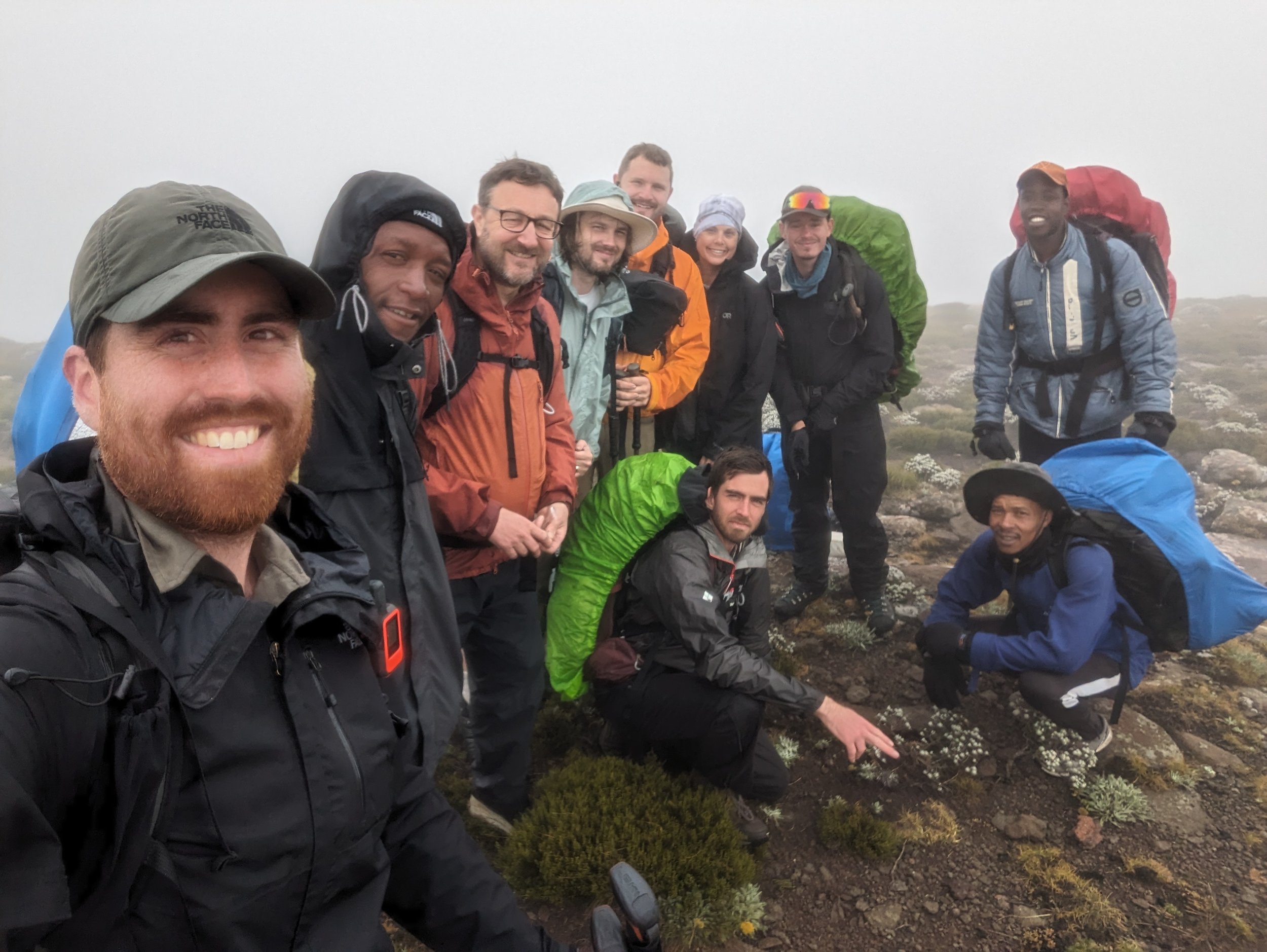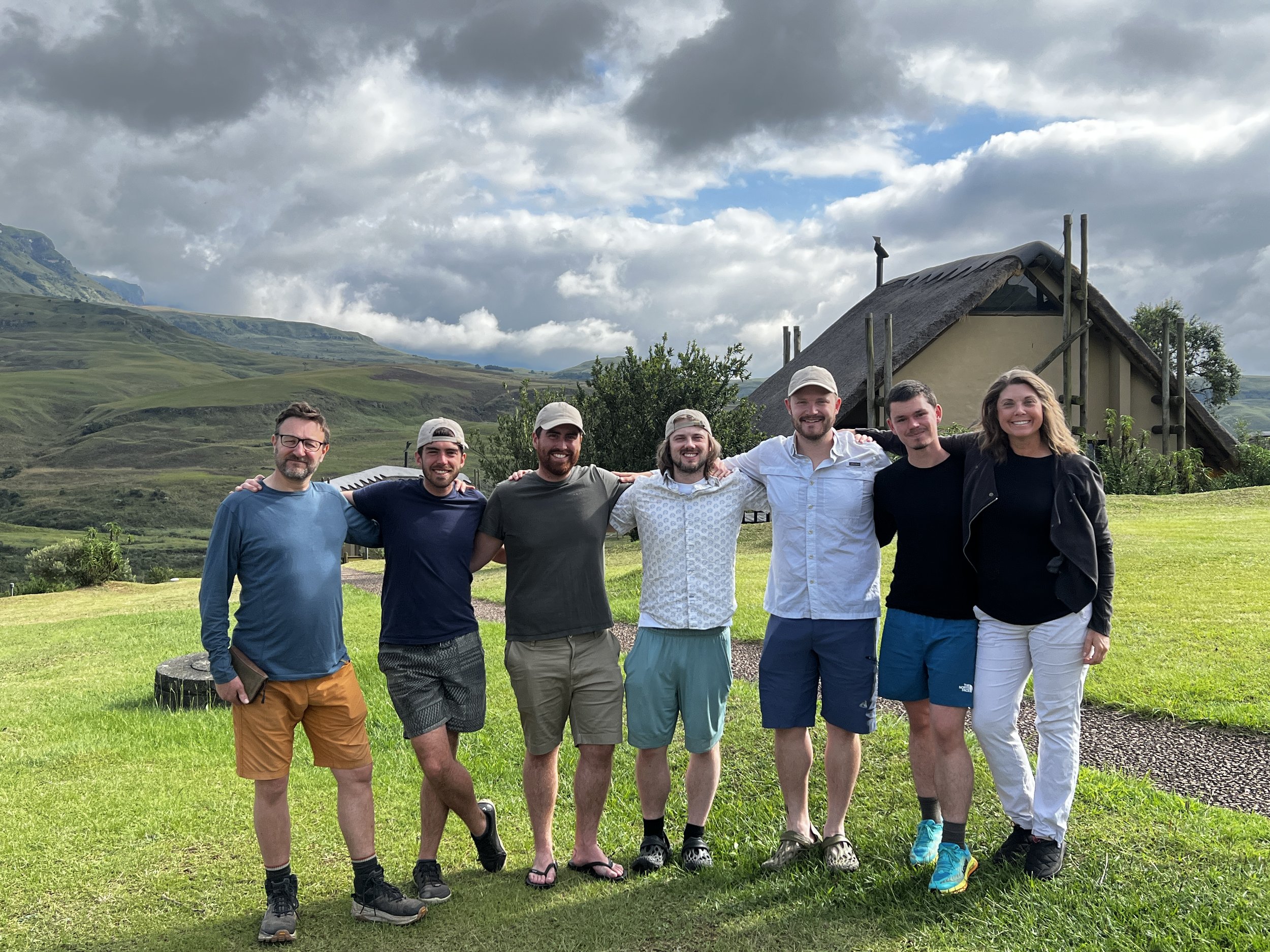Hiking and Photographing South Africa’s Drakensberg Mountains - The Northern Traverse (March 2024)
Prints of the photographs in this blog post are available to purchase. You can also join me on my next adventure in the Drakensberg! Alternatively, if you find value in my writing, photography, or just want to support my work then please consider making a small donation below. Thank you.
Realising a Dream (and Managing Expectations)
Well, visiting the Drakensberg has been many years in the making, but it finally happened. Delays; a trip that fell through; the build up, the anticipation, and excitement before actually getting there; the inevitable moments of doubt before setting off; all this dissipated when I took those first steps on trail. I knew then and there it was set to be an incredible week hiking in the mountains.
A number of years ago I contacted a few fellow South Africans with the idea of doing the northern traverse across the Drakensberg mountains. The goal was first and foremost just to witness the drama of the area, but also to potentially scout for photographs and future workshops. The Drakensberg is a UNESCO heritage site and hosts some of the most remote and stunning hiking routes found anywhere in the world - the perfect location for a wilderness experience and world-class photographic opportunities. Within the Berg, its epic Northern Traverse covers 75km at 3000masl over the course of 6 days, with roughly 3000m of ascent and plenty of descent (indeed, the final day would be something of a challenge, but more on that later). A group was slowly formulated, one of whom was ex-mountain rescue in the area and knew the mountains well. But, as things progressed, the trip eventually fell through with one person after another unable to make it for various reasons.
One of the tricky parts of planning these trips is partly climatic conditions: there are optimal windows to hike and photograph the Berg, namely March and October. Hiking can be done at other times, however being at such high altitude, the weather is highly unpredictable and can reach bitterly cold or hot temperatures if timed poorly. The original trip falling through meant at least a 6 month gap before another opportunity would come around - i.e. not quite enough time to put together a new group and organise things properly. So, I started from square zero and re-considered my options. The idea of a group of likeminded photographers coming together from all over the world was highly appealing to me, and being my first time revisiting the Berg since my youth, it made sense to take people who I knew would be competent in the mountains with a camera and would be happy to work on their own without my assistance. So, the invites went out. The appeal of dramatic mountains and the idea of a 6 day through-hike to immerse oneself in the environment really captured people’s imagination and the trip sold out. A second attempt at visiting these illusive mountains was born.
The group at the start of the hike, in a cloud inversion
Expectations
After waiting so many years to visit, the idea of the Drakensberg had taken on a life of its own in my mind: unfathomably large cliffs, endless mossy green fluvial ridges, perfectly piercing light, and of course the tallest waterfall in the world, Tugela Falls. Clearly, there were expectations that needed to be managed. For all my anticipation before the trip, the mountains have a mysterious way of humbling and re-centring those that dare visit. Sean, a client, and I had interesting discussions on the hike surrounding one of our favourite (although perhaps slightly cliché) quotes:
“I only went out for a walk, and finally concluded to stay out till sundown, for going out, I found, was really going in.” (John Muir)
There’s something about listening to the rhythm of your own footsteps, breath, and heartbeat as you climb a hill that focuses the mind. From the moment I took those first steps on trail, any preconceptions I was holding onto melted away.
There is little to no shelter on the barren escarpment, save for your tent. One is at the mercy of the mountains and their conditions: the sounds of wind whistling up the cliffs, a brilliant spark of lightning in a distant cloud, the beating sun at midday. All these factors immersed me in the environment, an immersion I find necessary to produce creative photographs. Six days is a significant length of time to spend in one environment, especially when hiking and camping without resupply. The very act of going on a long walk and the nature of self-reliance in such an extreme mountainous environment sharply focuses the mind and removes any expectations or distractions.
How does one do this? Why are expectations “bad”? There’s nothing inherently wrong with the excitement of visiting a new area. However, creatively speaking, I find that expectations detach me from the present moment. The thought that there could be better light, a different composition, or something “more” around the next corner distracts me from appreciating what is happening right in front of my eyes. It’s that simple act of appreciation - enjoying a moment of light or the shape of a cloud - which brings me back to the present and grounds my attention. Recognising a subtle moment of beauty not only leads to a better experience, but more fulfilling photographs. The Berg’s drama is pretty hard to ignore and each day I found myself repeatedly in awe of my surroundings.
The Hike
Northern Traverse Route (GPS Tracked)
Day 1
The group (6 in total, plus our guide and porters) met in Johannesburg and took our transfer to Witsieshoek Mountain Lodge, a rustic hotel set high up in the northern Berg. That evening we were all out exploring the hills around the lodge and watching the pastel afterglow of sunset burning on the mountains we were set to climb for the next 6 days. We woke up on Day 1 in the thick fog of an inversion, a clue of what was to come. After a hearty breakfast and double checking our bags, we set off to climb up the chain ladders, onto the escarpment plateau, passed Tugela Falls (which was disappointingly not flowing, however, something to revisit), and onto our campsite looking back north towards the falls and Sentinel Peak. After an incredible sunset and some fun photographing the tents in fog illuminated by headlamps and moonlight, it was time to head to bed to get some rest for a 5am wake up call - the pre-dawn glows in the Drakensberg are incredible and should not be missed. The inversion hung around for sunrise and we had some glorious moments of light before coffee and packing up camp to head out on our first true day hiking on the escarpment. Overall a very productive first 24 hours and the pressure to produce images had lifted.
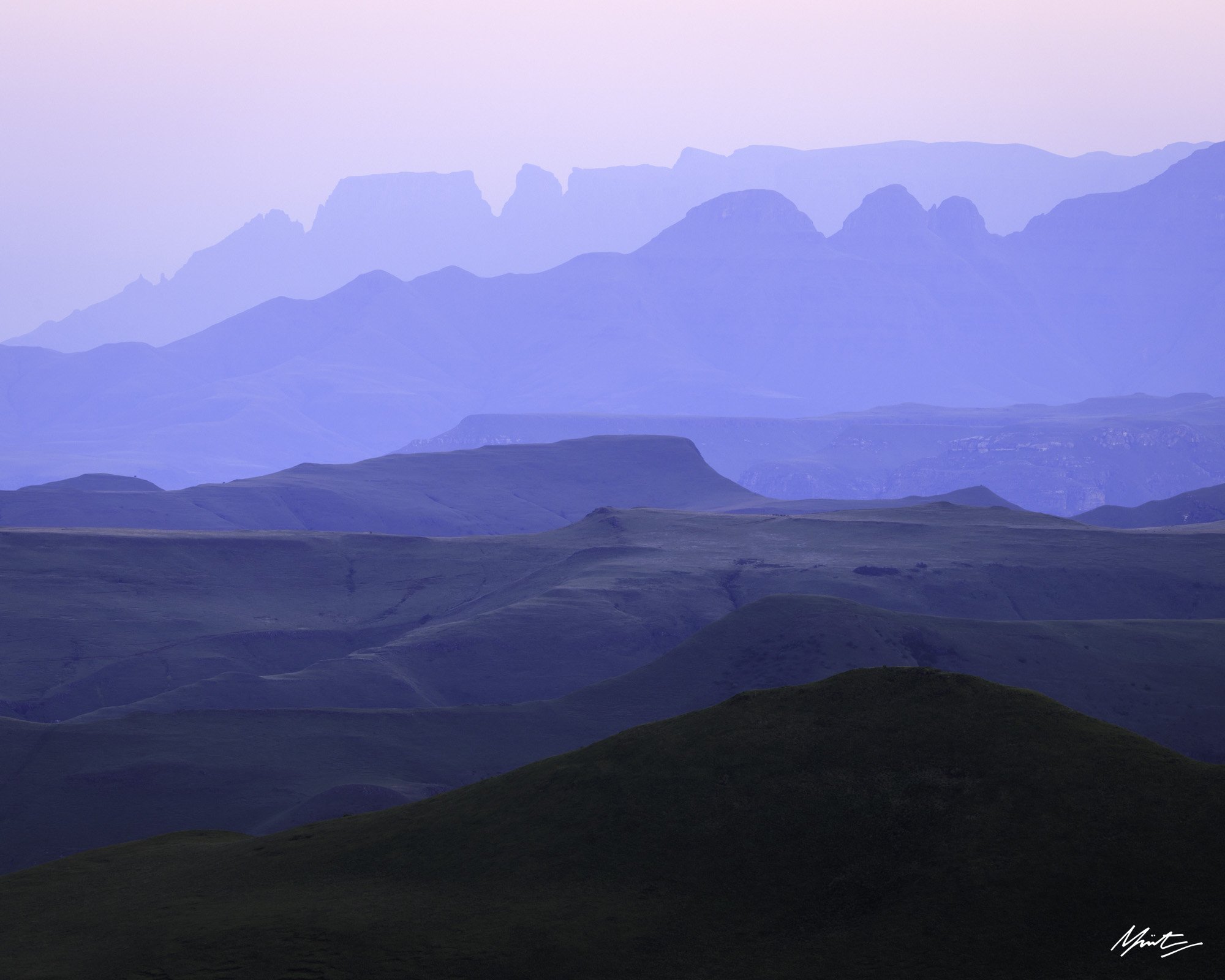
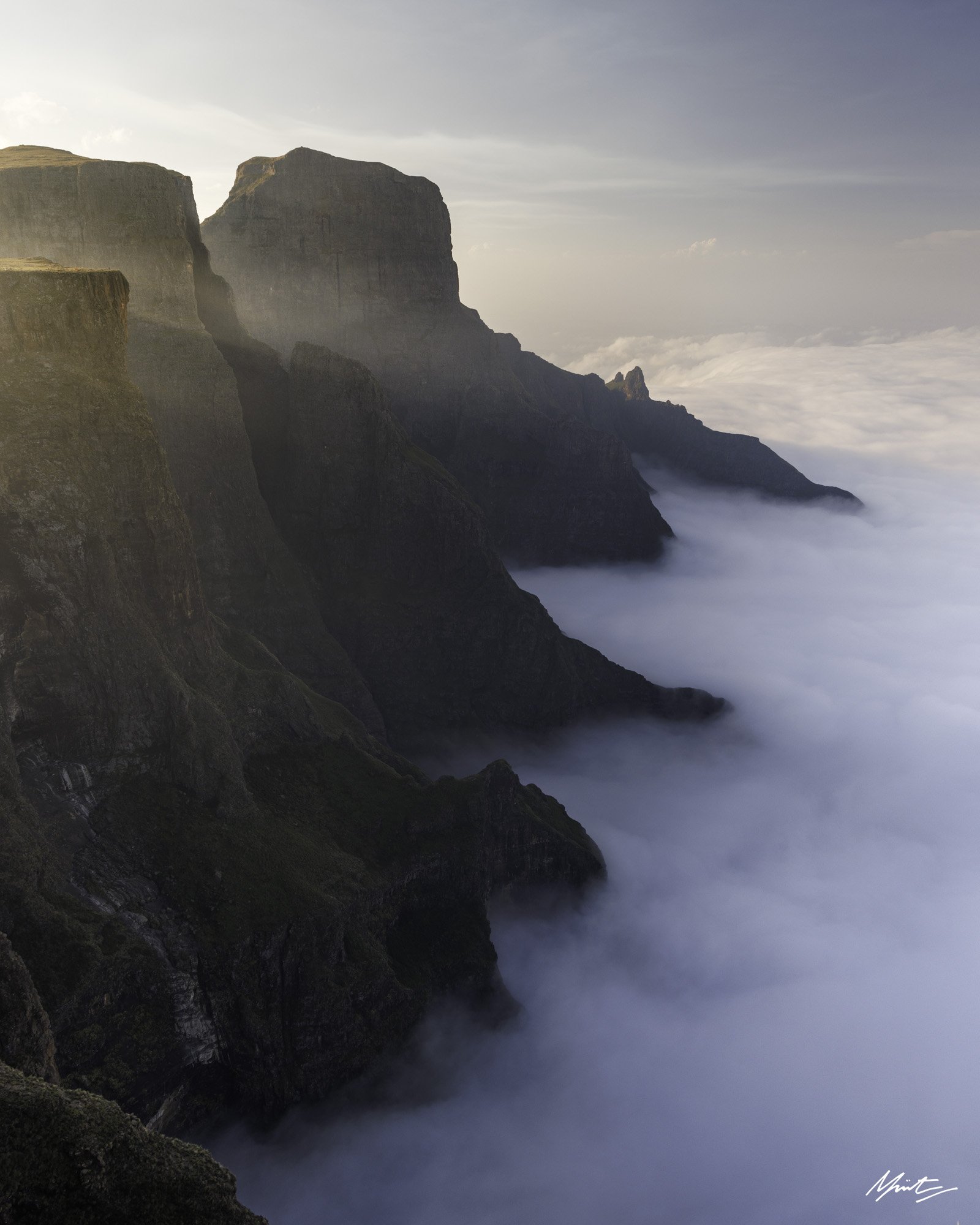
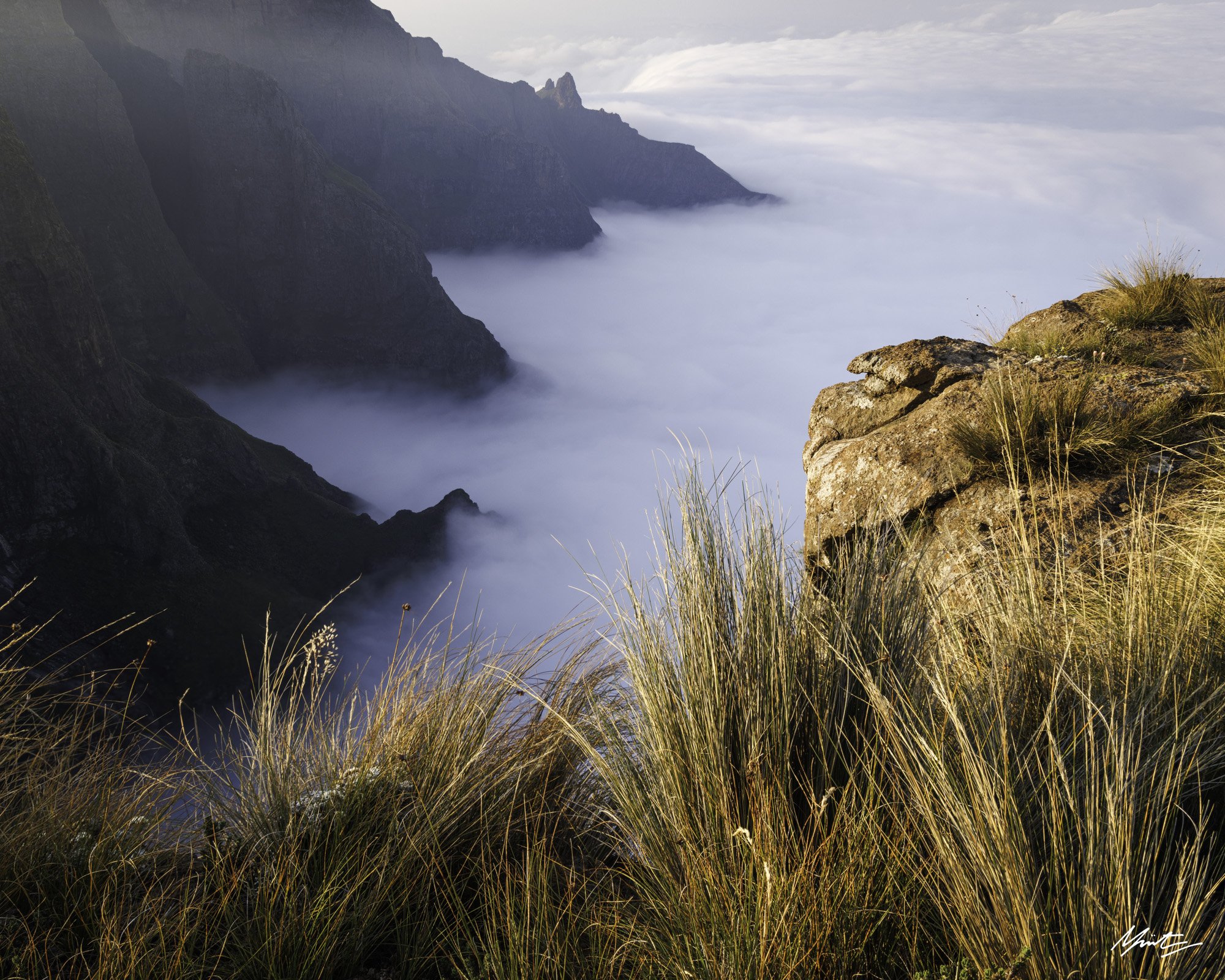
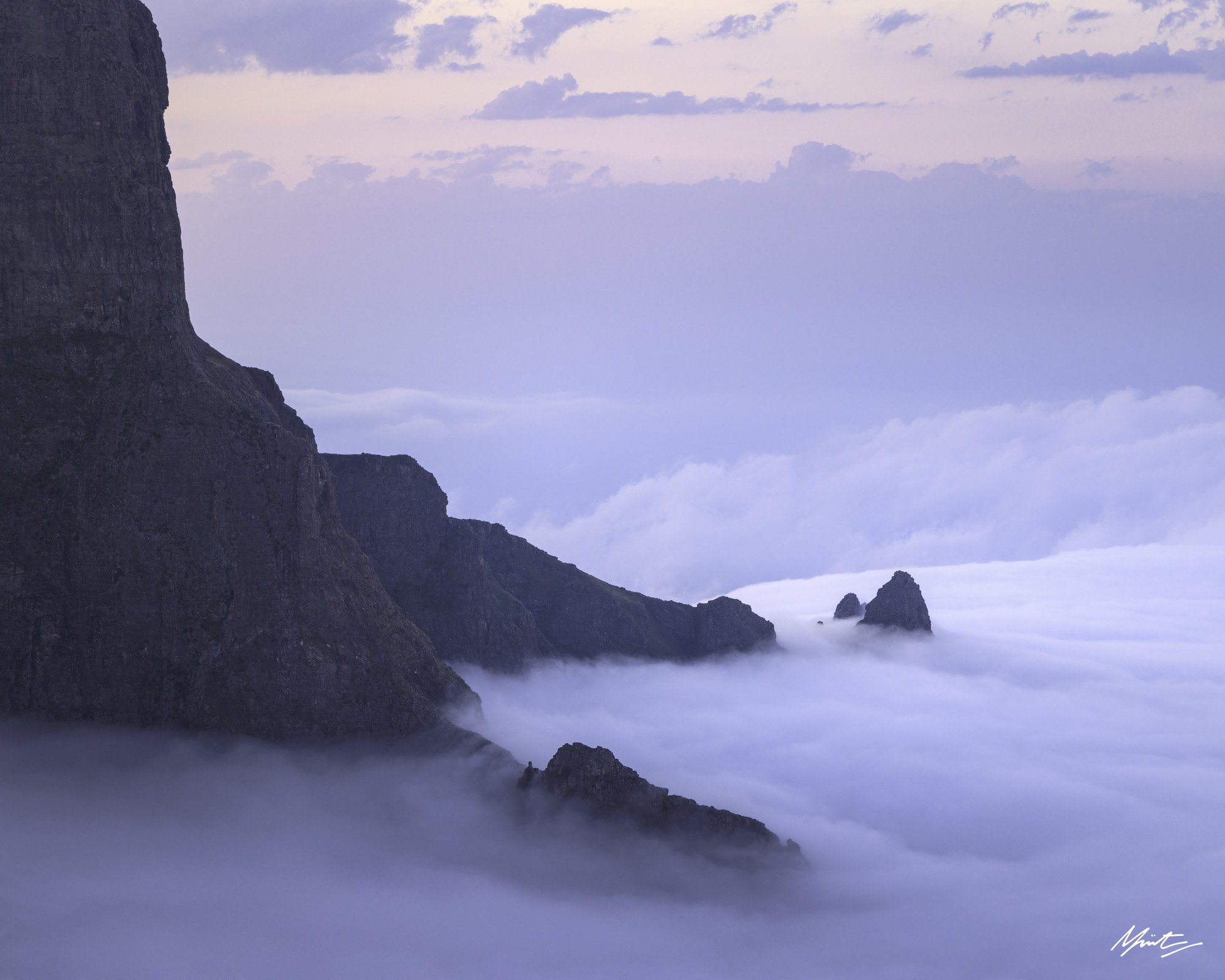
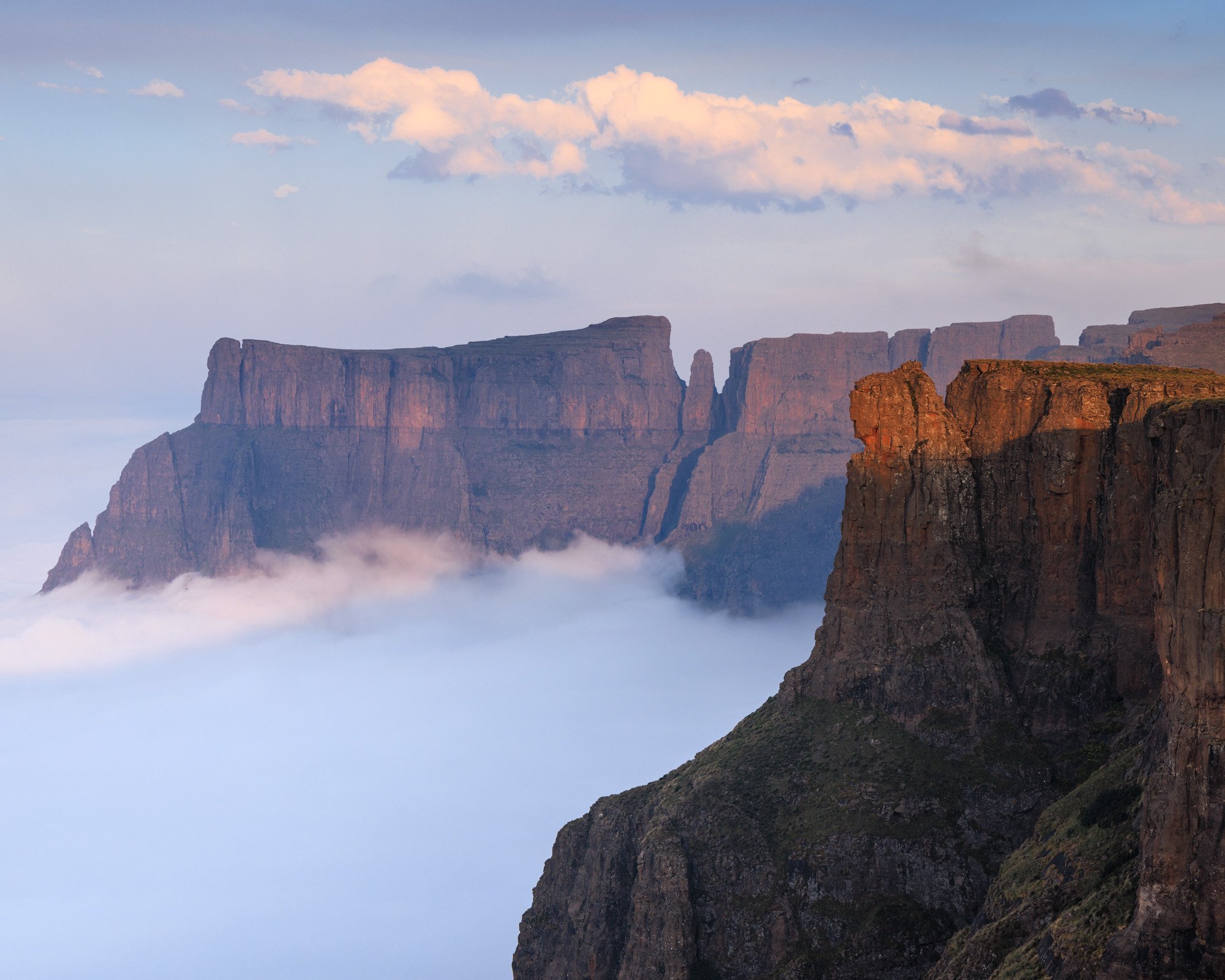
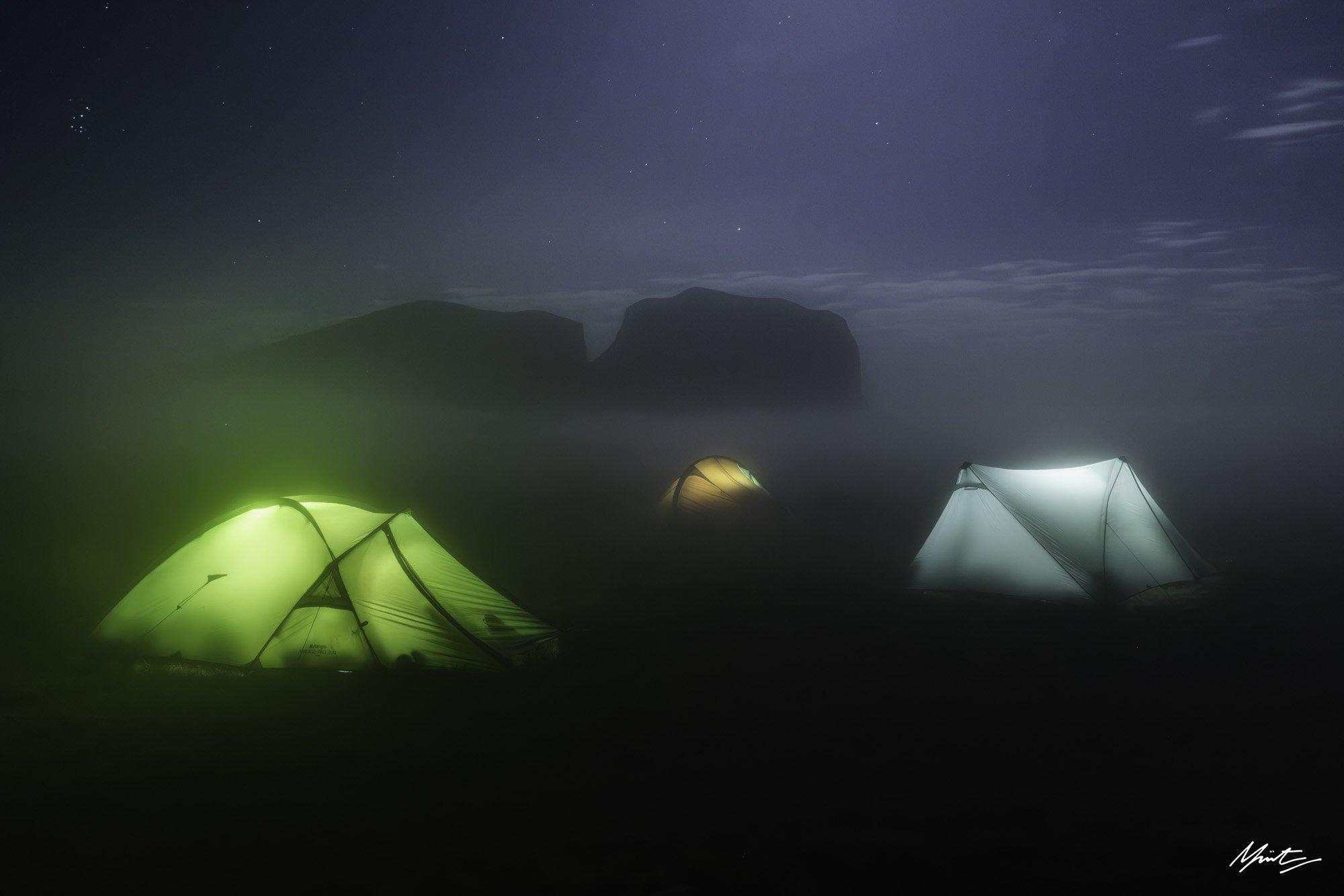

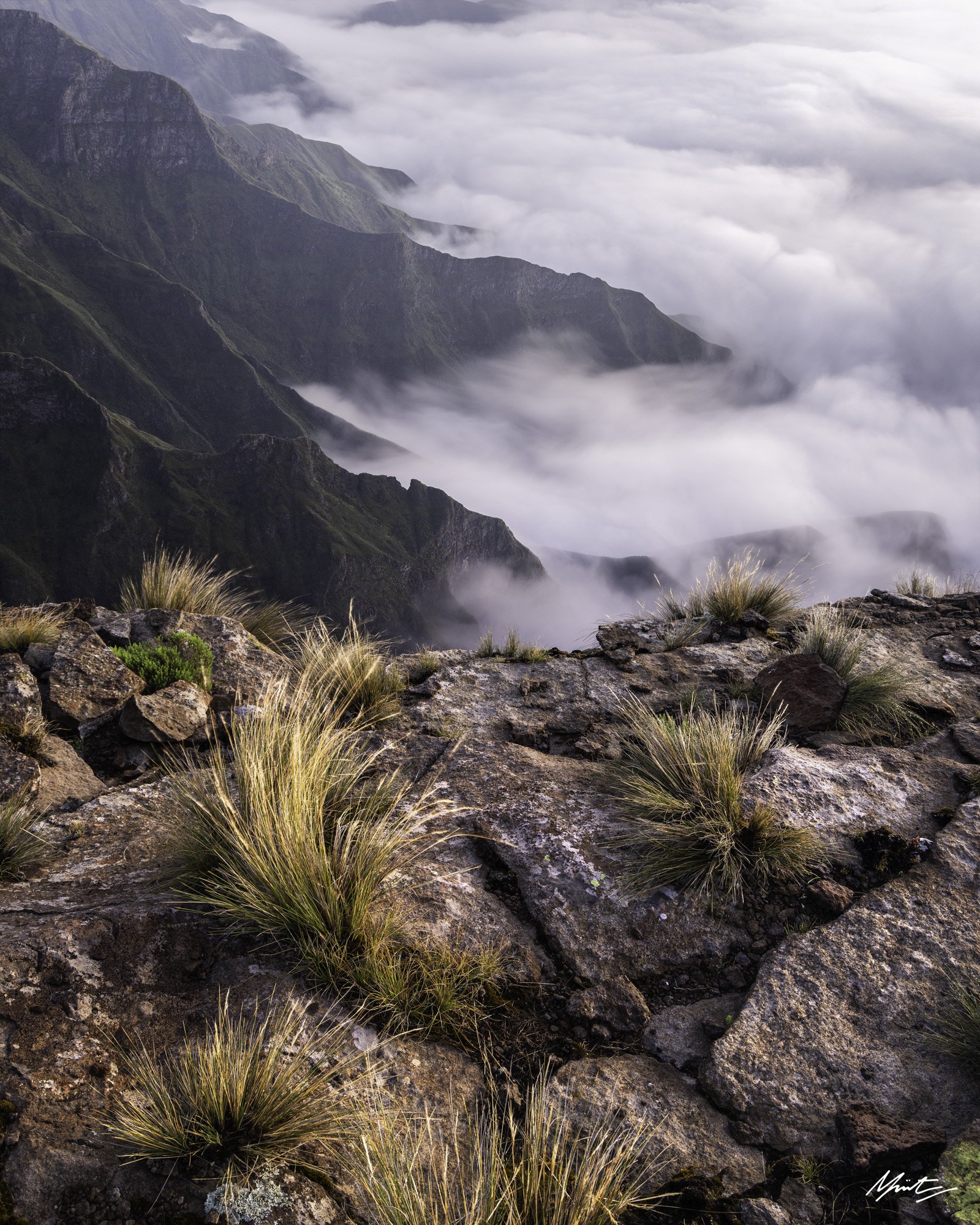
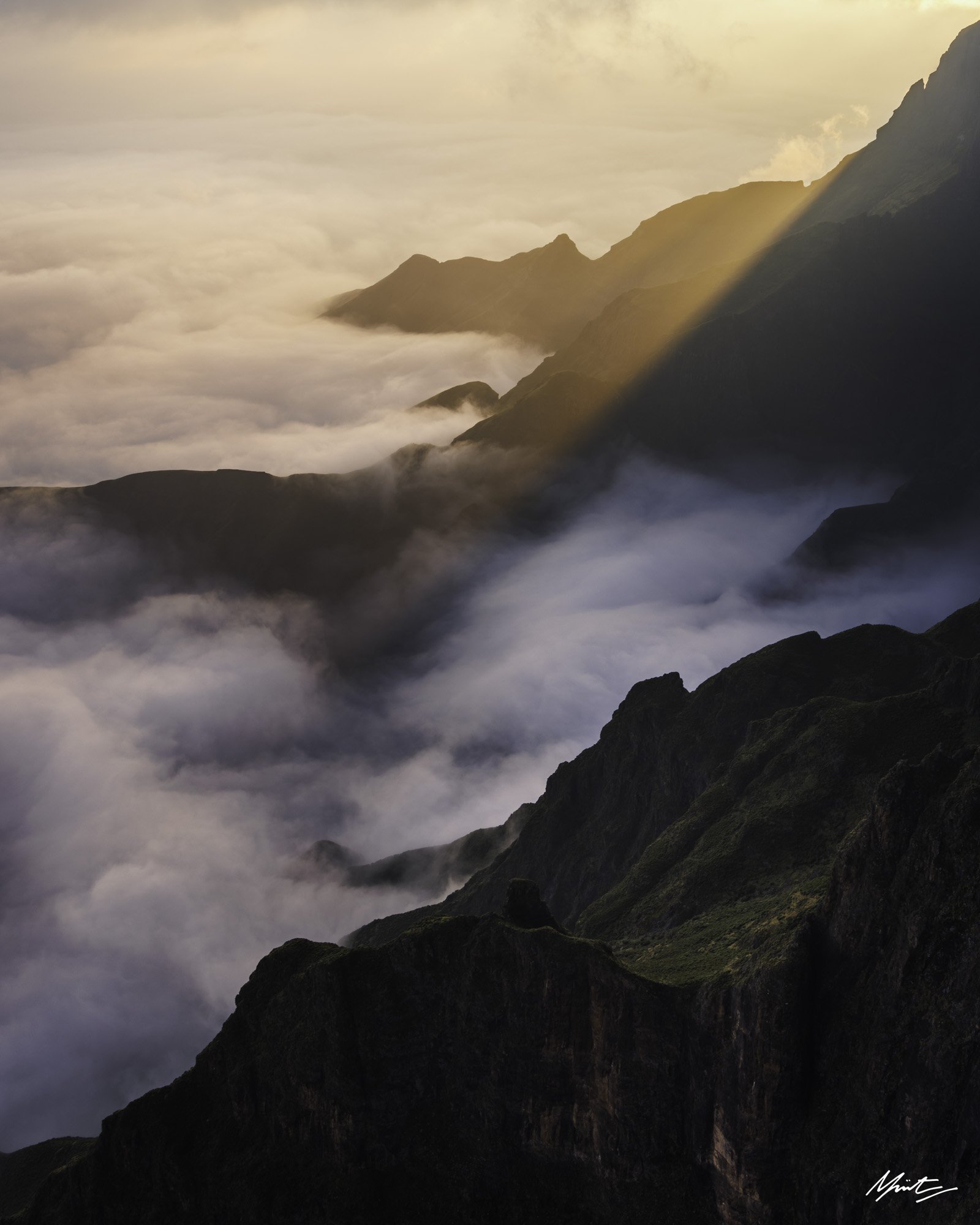
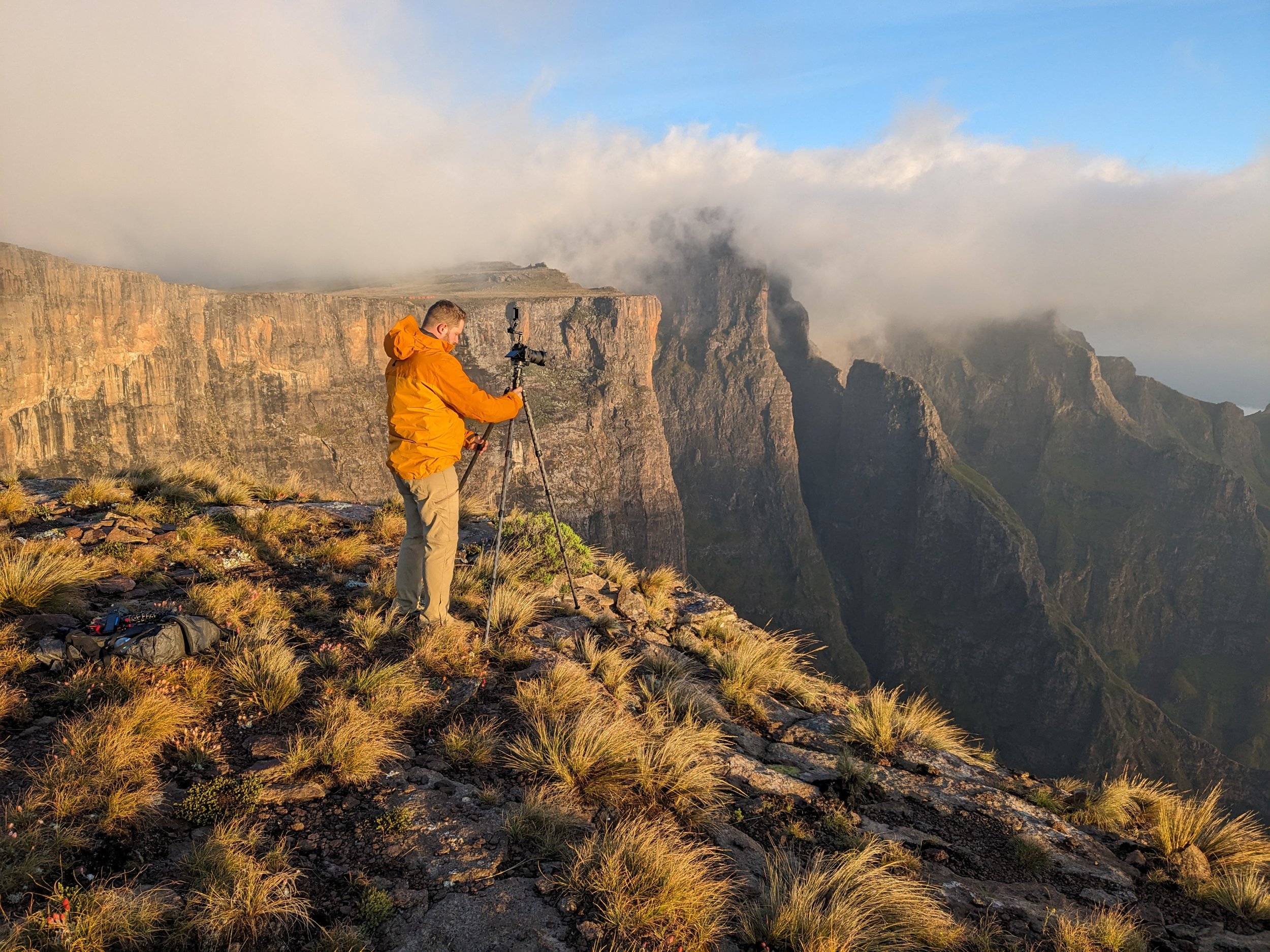
Day 2
This day would be the toughest for me, physically. Each of us seemed to have “a bad day”, but as a group we supported each other through any struggles. My body was still adjusting to the altitude, I was feeling slightly nauseous, and had a headache. A gruelling slog up one particular hill still sticks in my mind. The rewards at the end of the day were all worth it though. Our campsite lay right at the top of a steep valley home to the famous Madonna and her Worshippers, a series of rock spires precariously balanced on an impossibly steep cliff face. Once again we were treated to a cloud inversion (they add tremendous depth, atmosphere, and mystery as well as block any lights from townships at the bottom of the escarpment) and incredible sunset light. The 5am rhythm continued the following morning, although just for me, as some of the group had been up in the night attempting to photograph the milky way. A brief moment with a burning sunrise, all to myself.
Day 3
We hiked passed the Mweni Pinnacles, crossed the source of the Orange river, and headed onto our campsite just south of Rockeries (a sheer sided flat topped cleft) with an incredible view towards North Peak. Camp was set up and I was excited to explore the views and scout compositions, so I headed up the hill - some additional walking uphill is usually needed to get to the view points - only for a storm to start rolling in. No faster had I reached the escarpment edge had the winds picked up and the rains started, so I quickly retreated back to camp. Sheltering from the thunder and thoroughly tired by this point, the call of “rainbow!” came from our guide’s tent. An incredible double rainbow was placed perfectly over the top of North Peak (just visible from camp) and mammatus clouds eventually rolled in behind the clearing storm. While the conditions were beautiful, my body had other ideas. After a full day of hiking and a quick scramble up and down the hill, I needed to rest. The rest of the group had smartly waited until the storm passed to then head up the hill - lesson learned. Nevertheless, it was a joy to witness the breaking light and cloud formations over camp.
The following morning, set on making up for my errors the night before, I headed back up to the escarpment edge in the dark. The inversion this morning was set some ways back, revealing the flutes and ridges running down far into the valley below. As I stood there watching the glow of daybreak, the clouds slowly began to creep into the valley, eventually swallowing it up. A memorable moment and one of my favourite images of the trip.
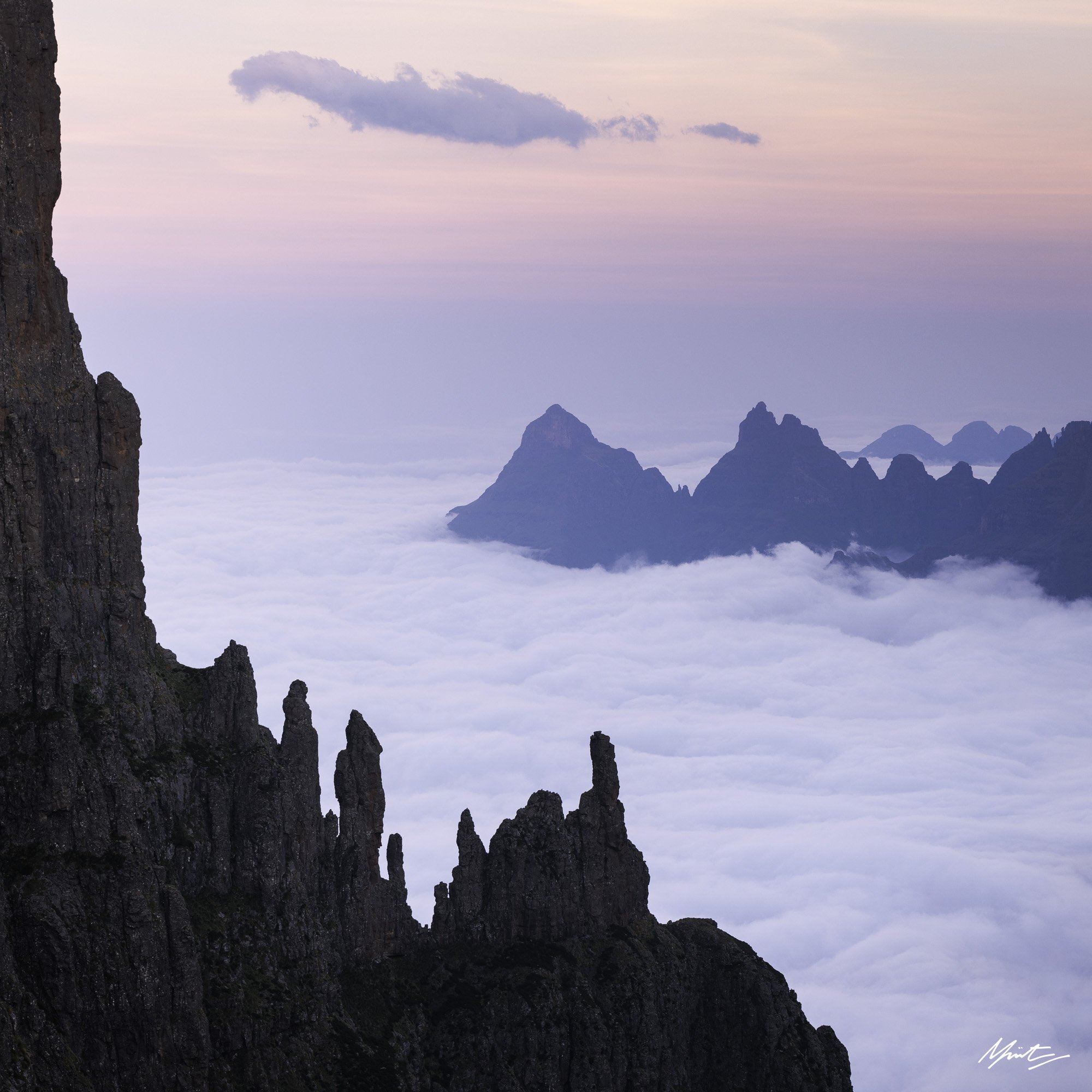
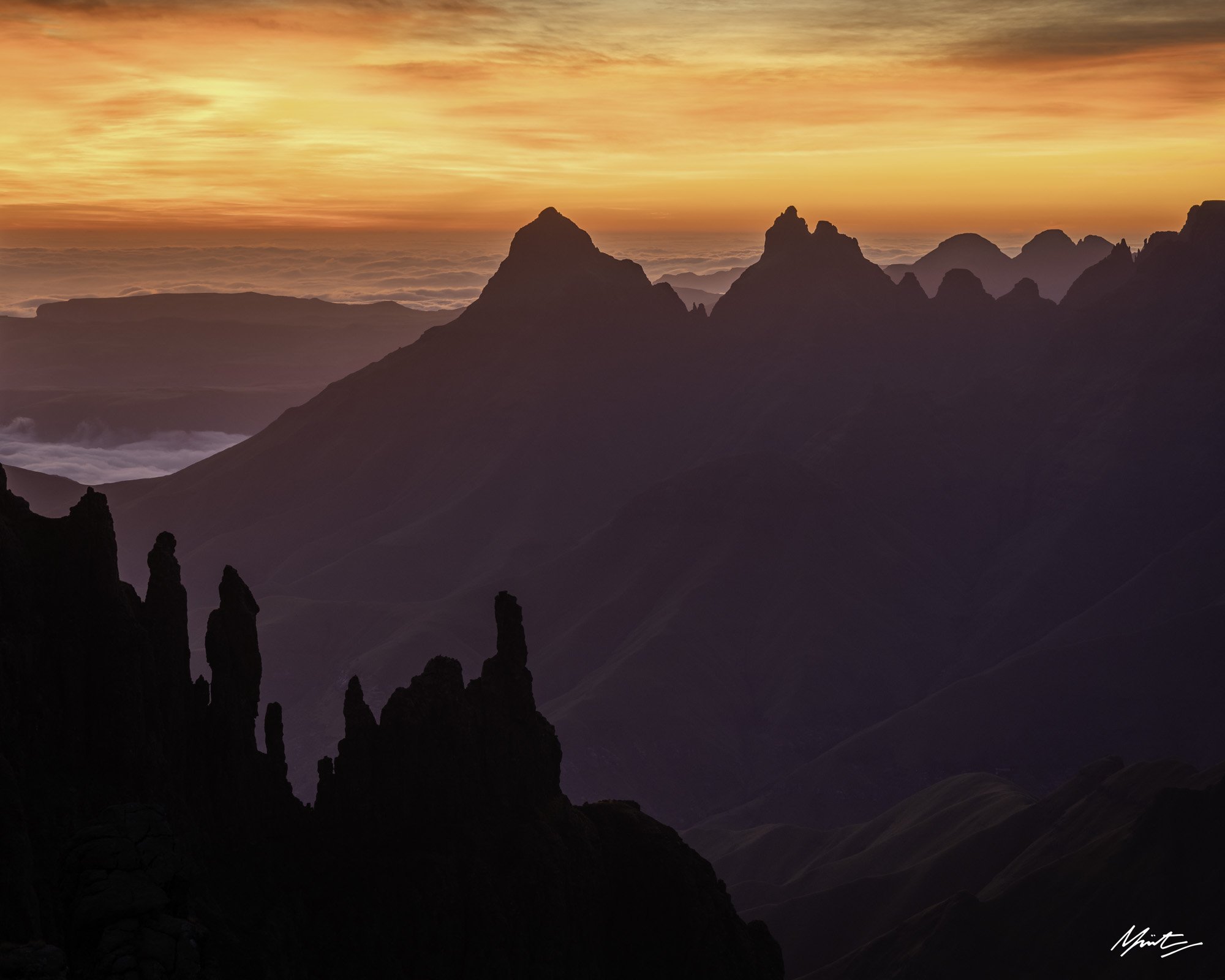

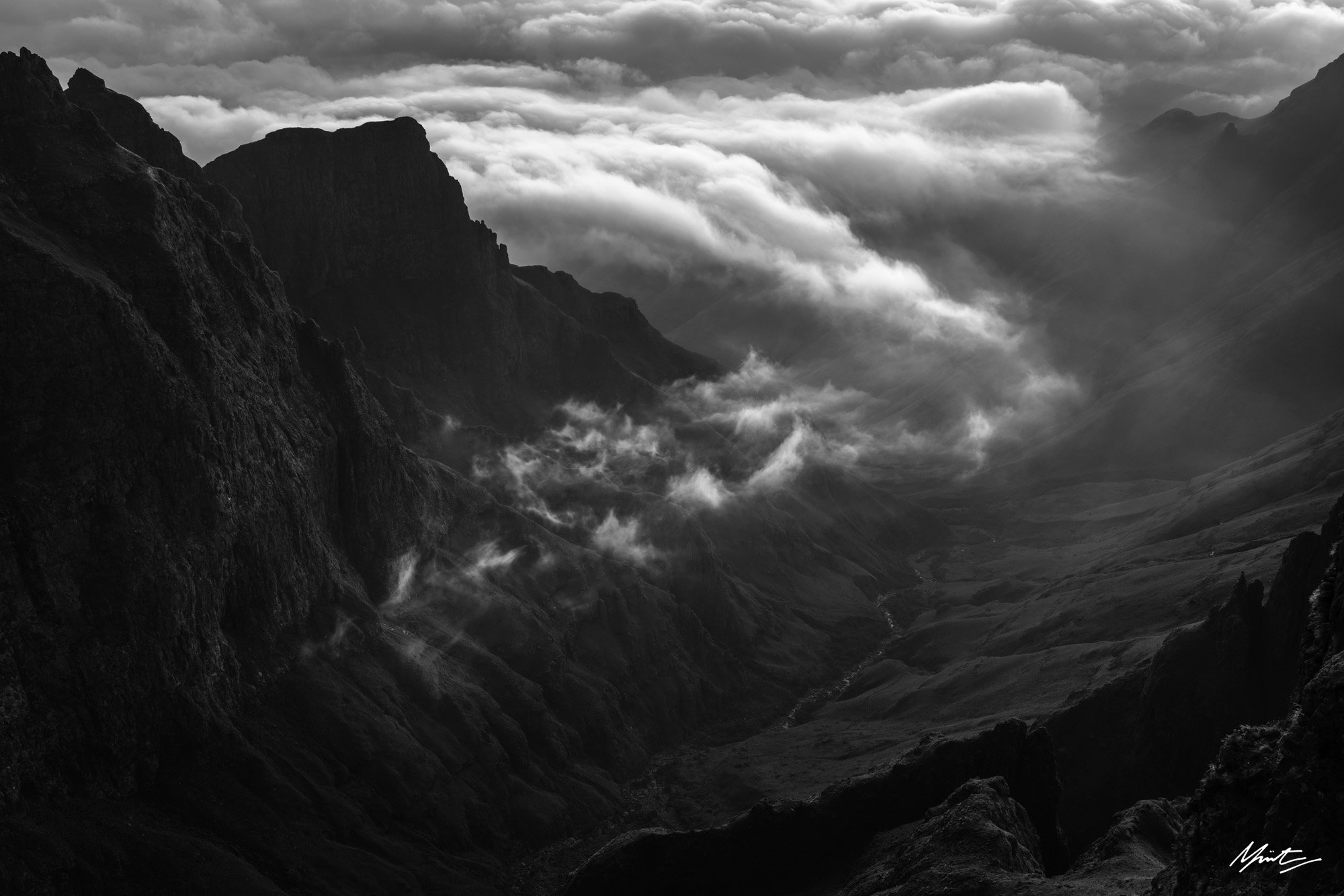
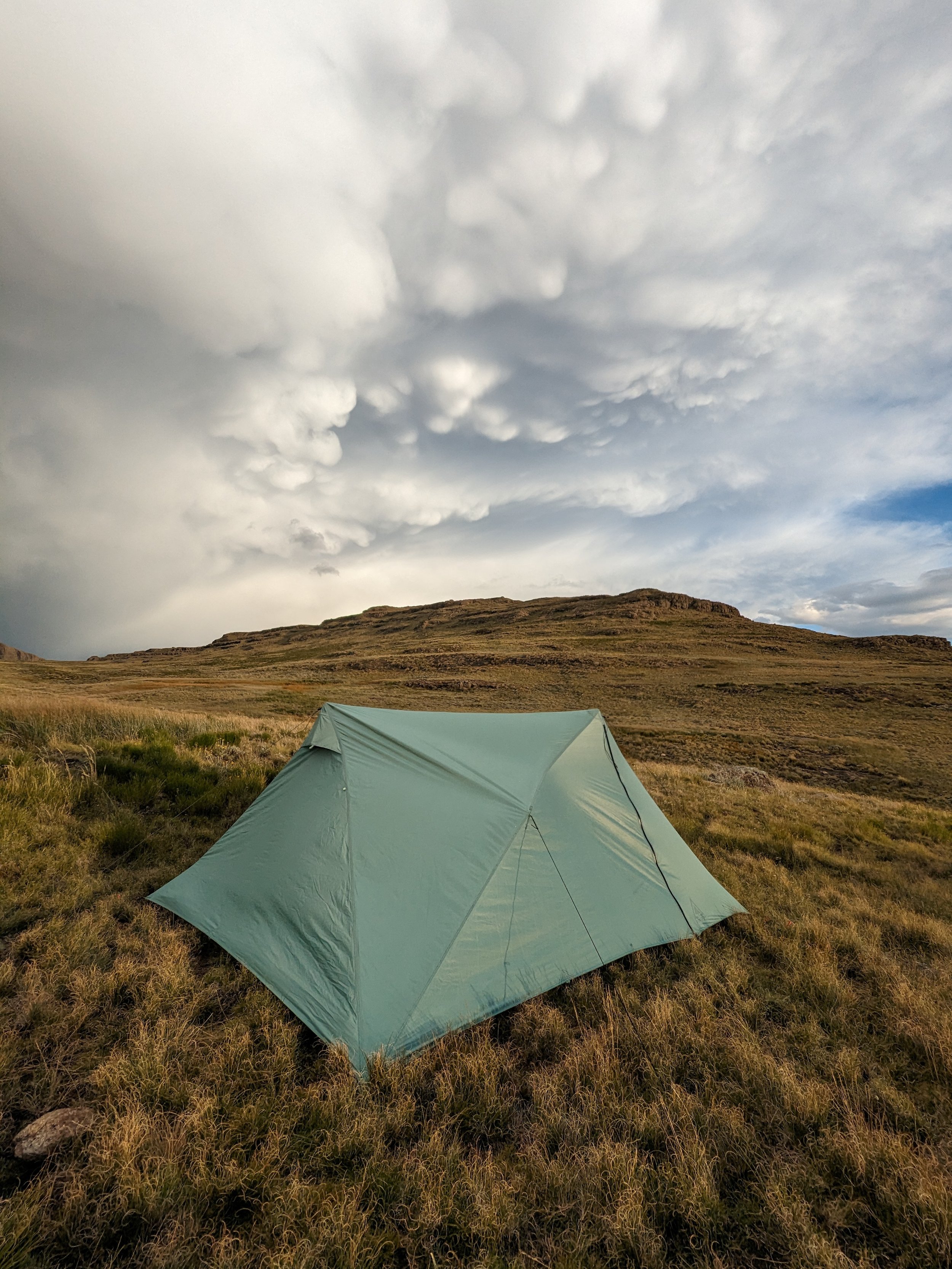
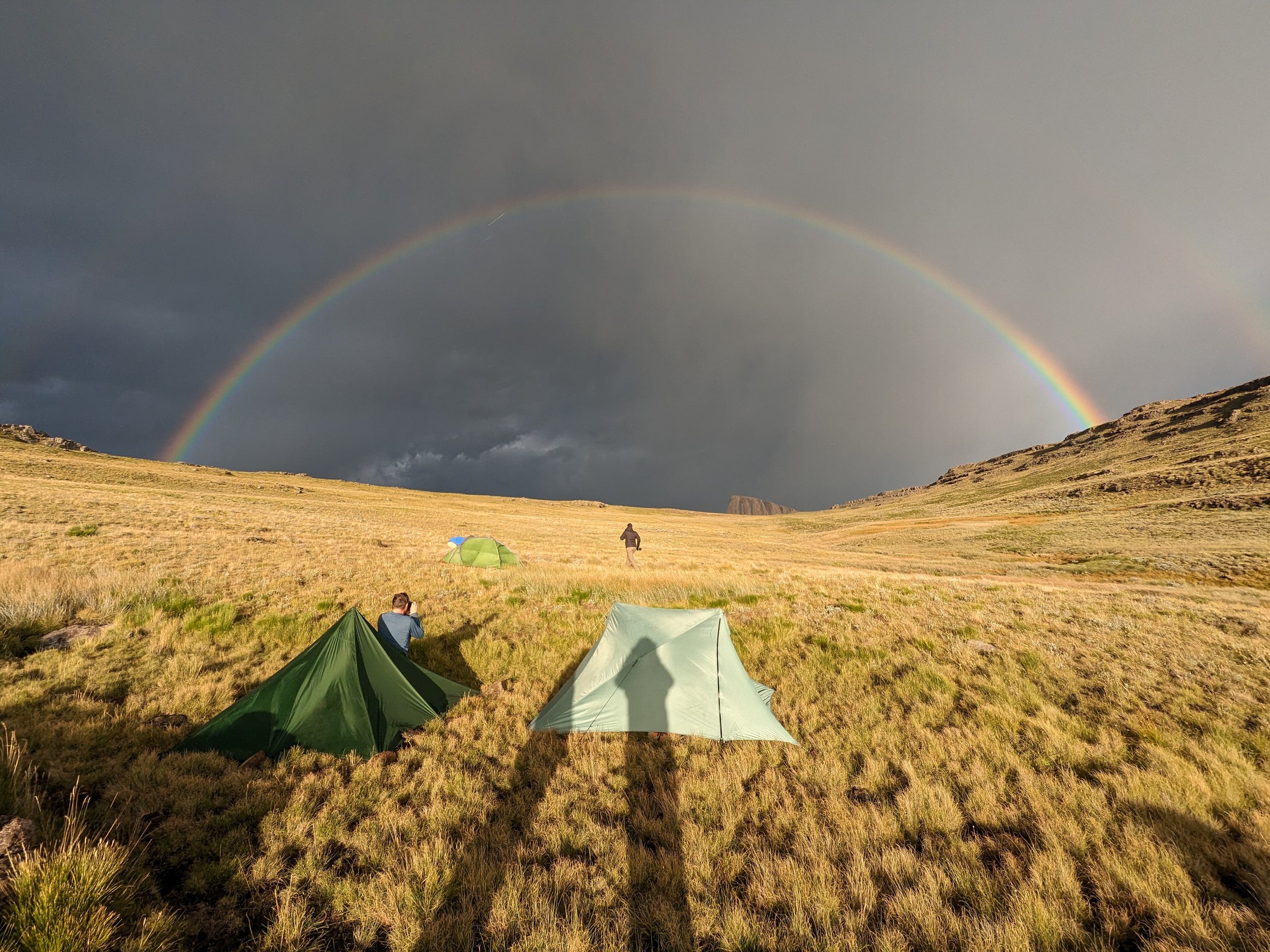
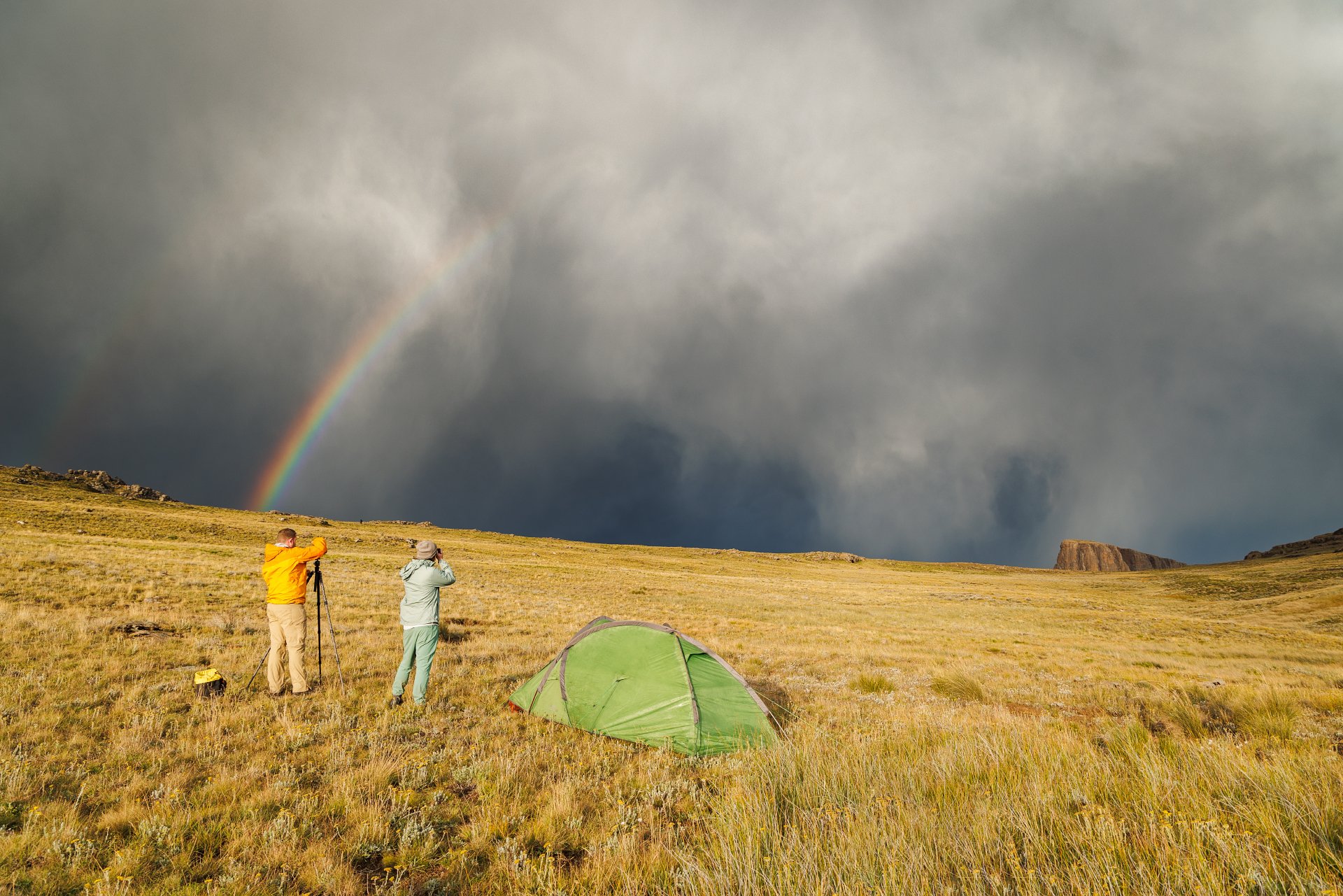
Day 4
We set off for another long day of hiking, along the Mweni Saddle, crossing streams and venturing through the Lesotho highlands. One of the unexpected highlights was definitely our interactions with some of the shepherds that live high up in the mountains for months at a time. Everybody we met was kind and greeted us with a big smile. They would come running down from elevated vantage points, clearly unfazed by the altitude and steep terrain, all to ask for a sweet or cigarette. It’s custom to “trade”, rather than simply gift, so a few people in our group would occasionally ask to take their photographs. The shepherds, often accompanied by their working dogs, wear incredible handmade merino wool cloaks, balaclavas, hats, gumboots, and are typically using a walking stick of some kind. After some rain (much needed - the rivers were as dry as our guide had ever seen them at this time of year), eventually we made it to our campsite just below a monumental amphitheatre of cliffs.
Two Shepherds stand in front of the escarpment
A few of us once again ventured up a hill to gain a different perspective on our surroundings. We scouted a few compositions for the following morning on the way up, with elegant grasses, detailed white bushes, and swooping rocks in the foreground before reaching the top of the hill. More rain and clouds rolled through the mountains, providing atmosphere and mystery to the gigantic sandstone faces - a stark difference in conditions to the relatively clear skies and colourful landscapes we had been experiencing the last 4 days. I quickly fired off a few frames, shielding the camera lens from the driving rain as best as I could, and came away with one particularly moody frame.
Day 5
As if the photographic conditions so far hadn’t been good enough, the following morning would prove to be one for the memory books. The set up was classic: high cloud and a gap on the horizon. A pre-dawn glow reflected beautiful pinks and reds onto the mountains (in fact, the entire valley was almost unnaturally awash with pink light), but it was sunrise that was truly special. A burst of orange light directly illuminated the sandstone cliffs providing depth and drama.
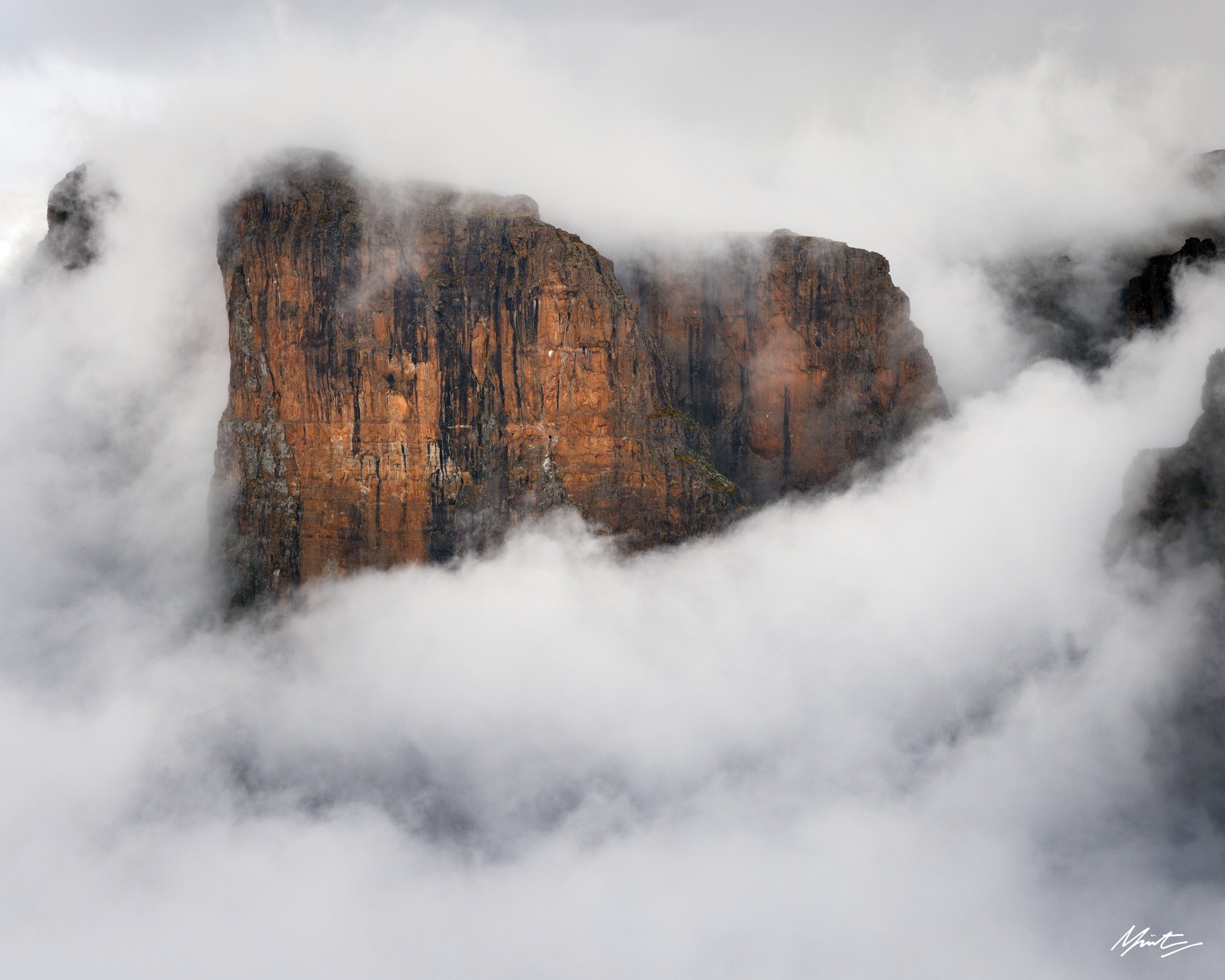

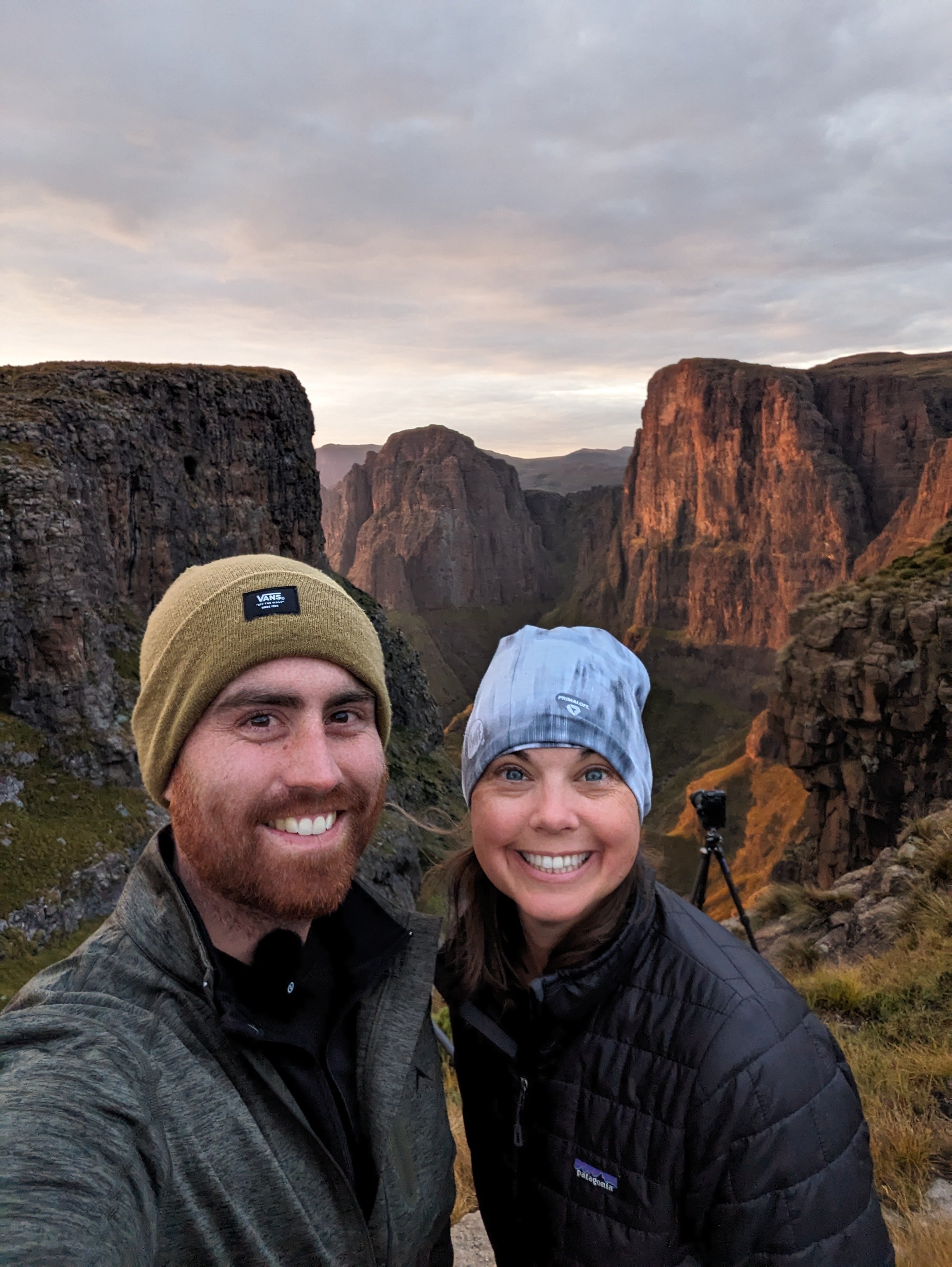
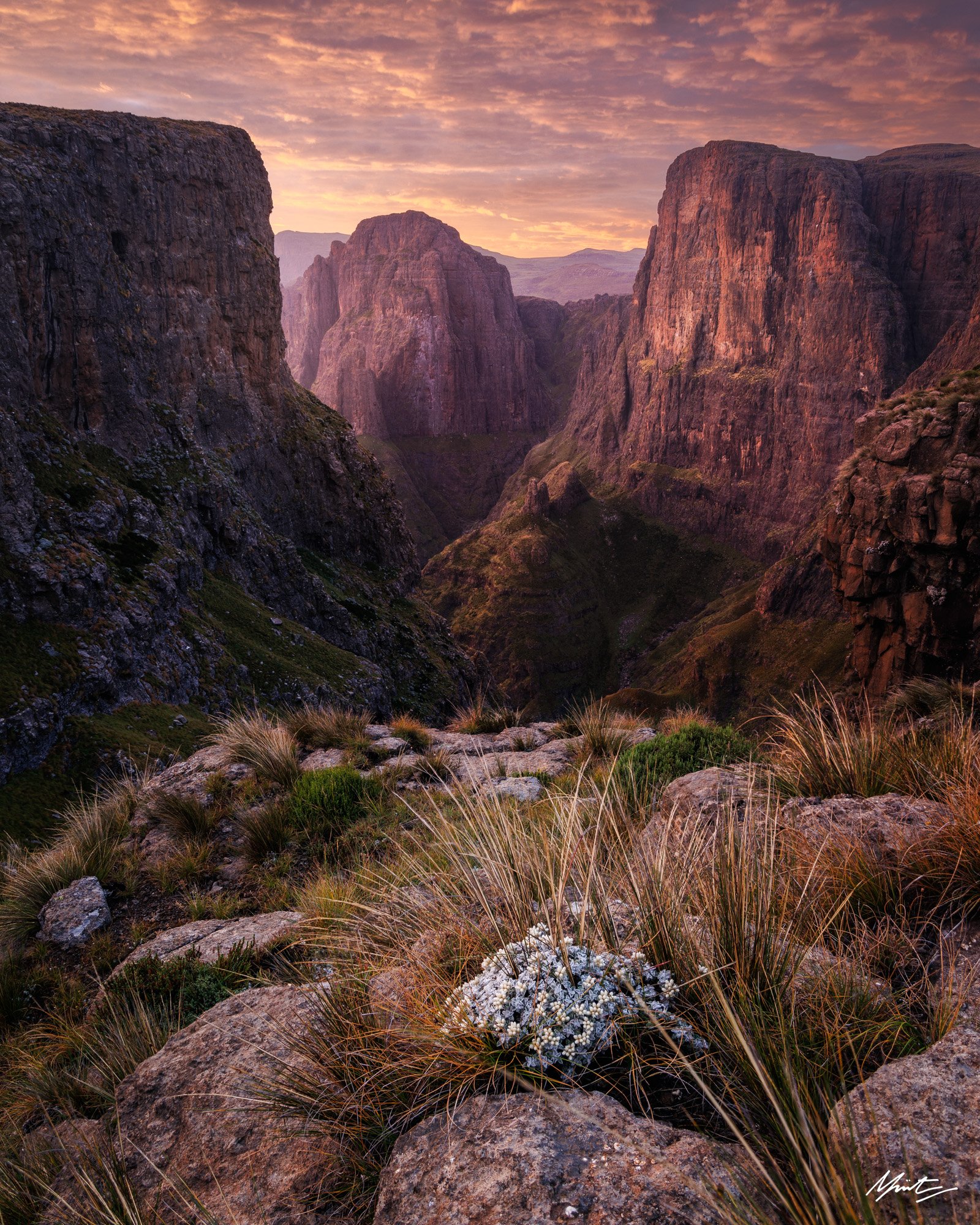
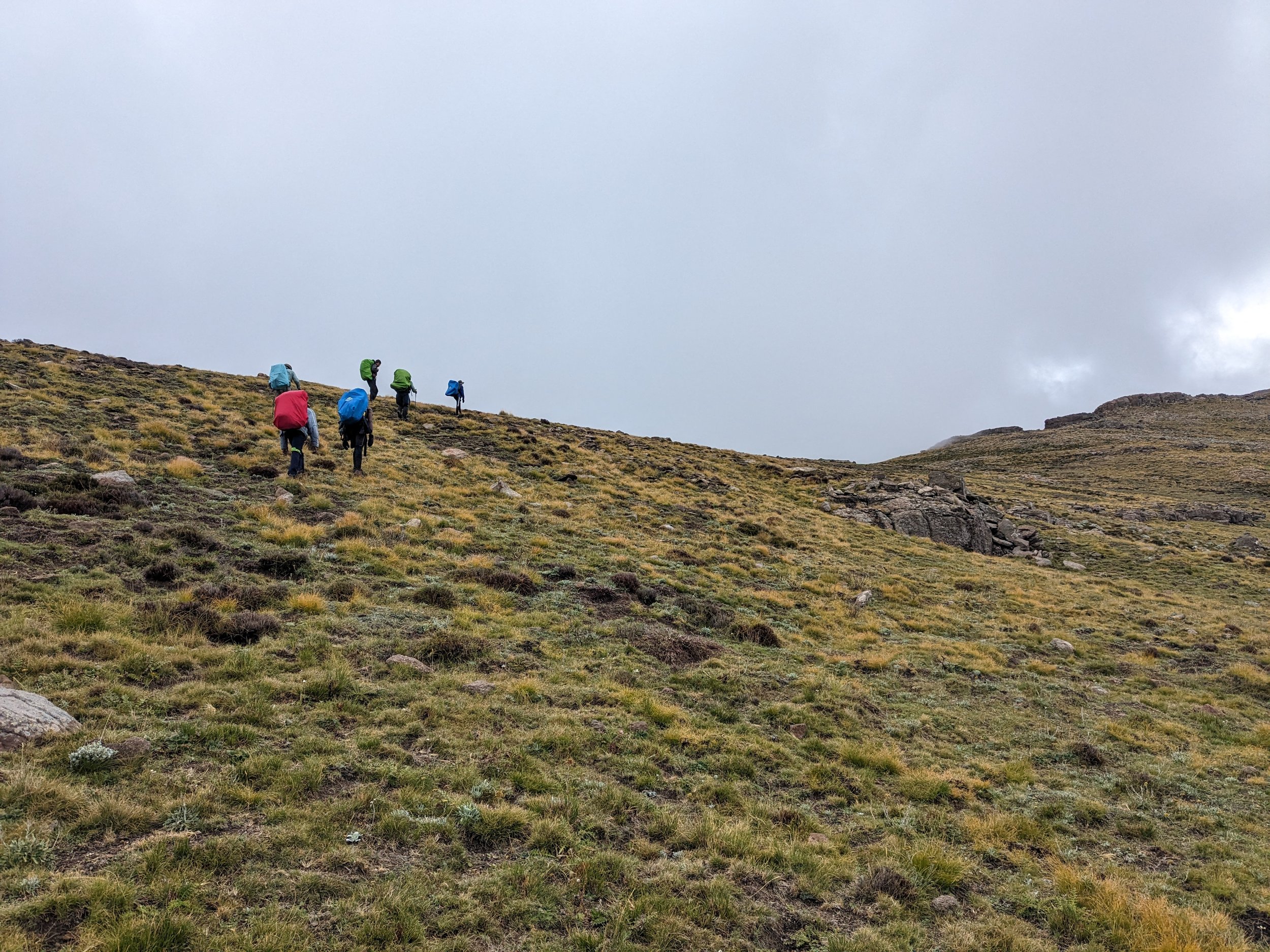
Today, we would reach the highest point of our hike, Cleft Peak at ~3281masl. First though, a steep descent. It’s always slightly demoralising knowing the hill you need to go over requires losing a bunch of elevation first. But it wasn’t the subsequent 500m of elevation gain that would be the story of the day; thunderstorms were rolling in. We would need to time our ascent carefully as, needless to say, being at the top of the highest peak in the area during a storm would be unnecessarily risky. So, just before gaining the ridgeline, we sheltered for some 20 minutes while a lightning cell passed overhead. It was then a b-line for the summit, a quick high-five in the clouds (unfortunately we didn’t get any views), before a fast descent to safety and our campsite. Overall, a thrilling, if wet, experience!
The clouds we had just hiked through lowered on us once again and we got the tents set up just in time before more heavy rain. Our final campsite was just above Organ Pipes Pass, so named for its fluted pillars of rock that line the top of the valley. Sunset was snuffed out, and so all that was left was our final sunrise, and what a morning it would be.
The group at the summit of Cleft Peak!
Day 6
Our final day on trail. Everyone was up in the dark to make the long walk up (some 140m of additional ascent) to what would turn out to be one of the most spectacular views of the whole hike looking back towards the full Cathedral Peak ridge and the escarpment’s many peaks beyond. A beautiful glow began to break out and just the hint of an inversion in the distance gave wonderful atmosphere in the distance with crisp detail in the nearby mountains. This section of the Drakensberg has intricate fluvial ridges, or eroded channels in the mountainside, that race down to the valley floor below. A crisp wind had picked up that morning, but nothing could detract from the views in front of us: alpenglow on the peaks, beautiful wispy clouds, followed by direct orange light as the sun finally rose above the horizon. We all stayed at the summit view for some time making images before wandering halfway back down the hill to get a look right down into Organ Pipes Pass from above. The countless layered ridges were just catching first light, creating a dynamic abstract scene of green and gold. I made a few last images before heading to camp to pack up and start the long descent down to Cathedral Peak Hotel.

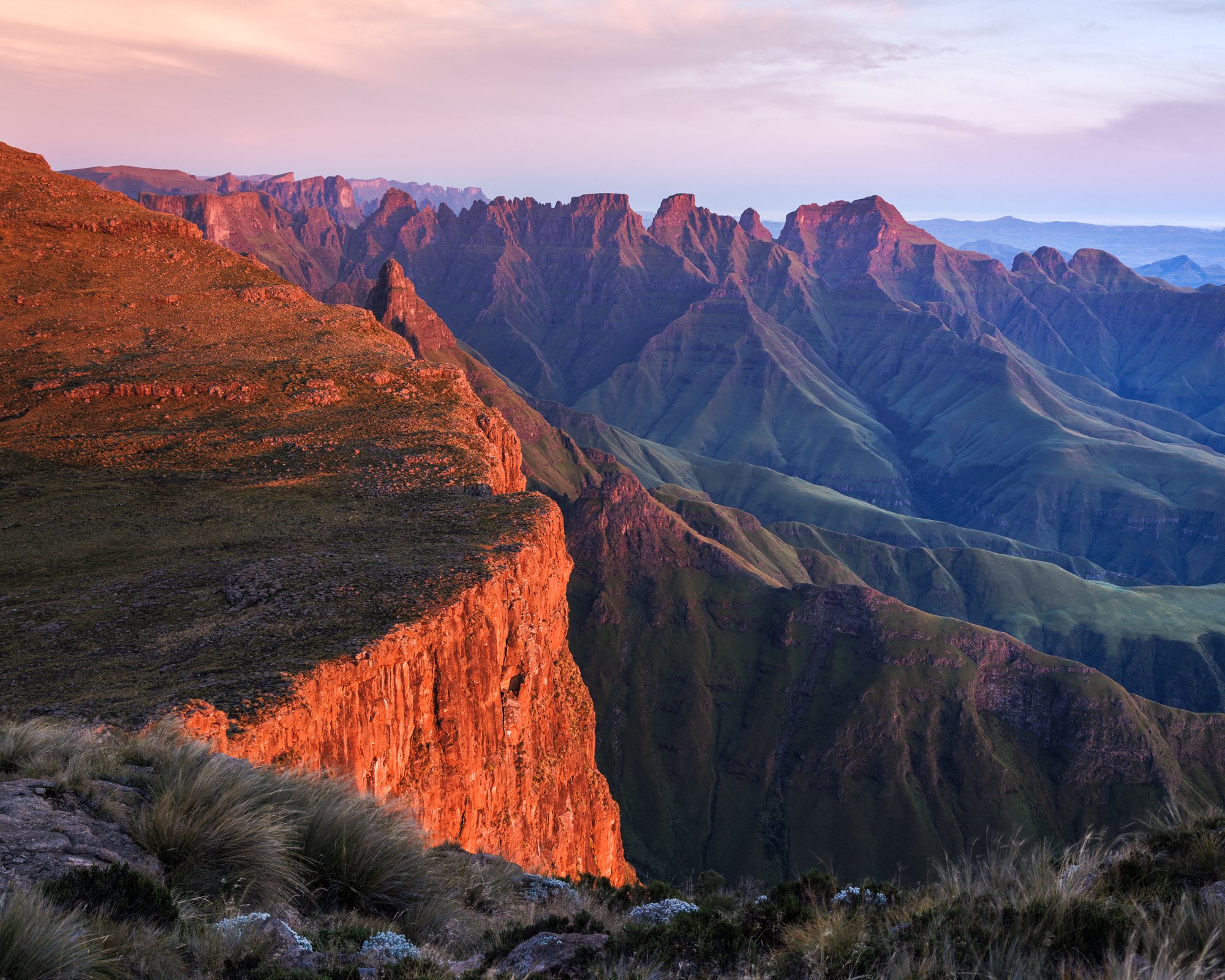
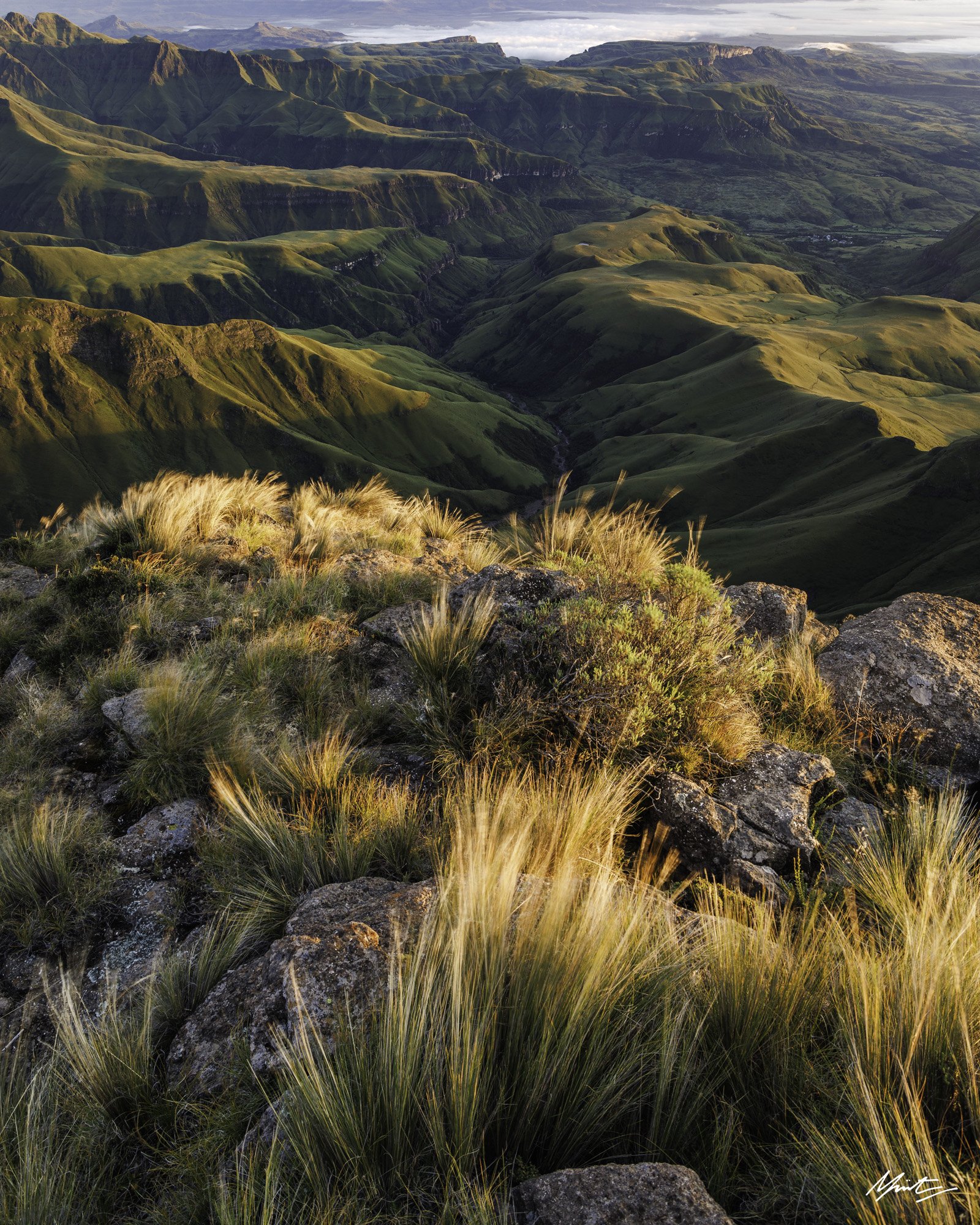
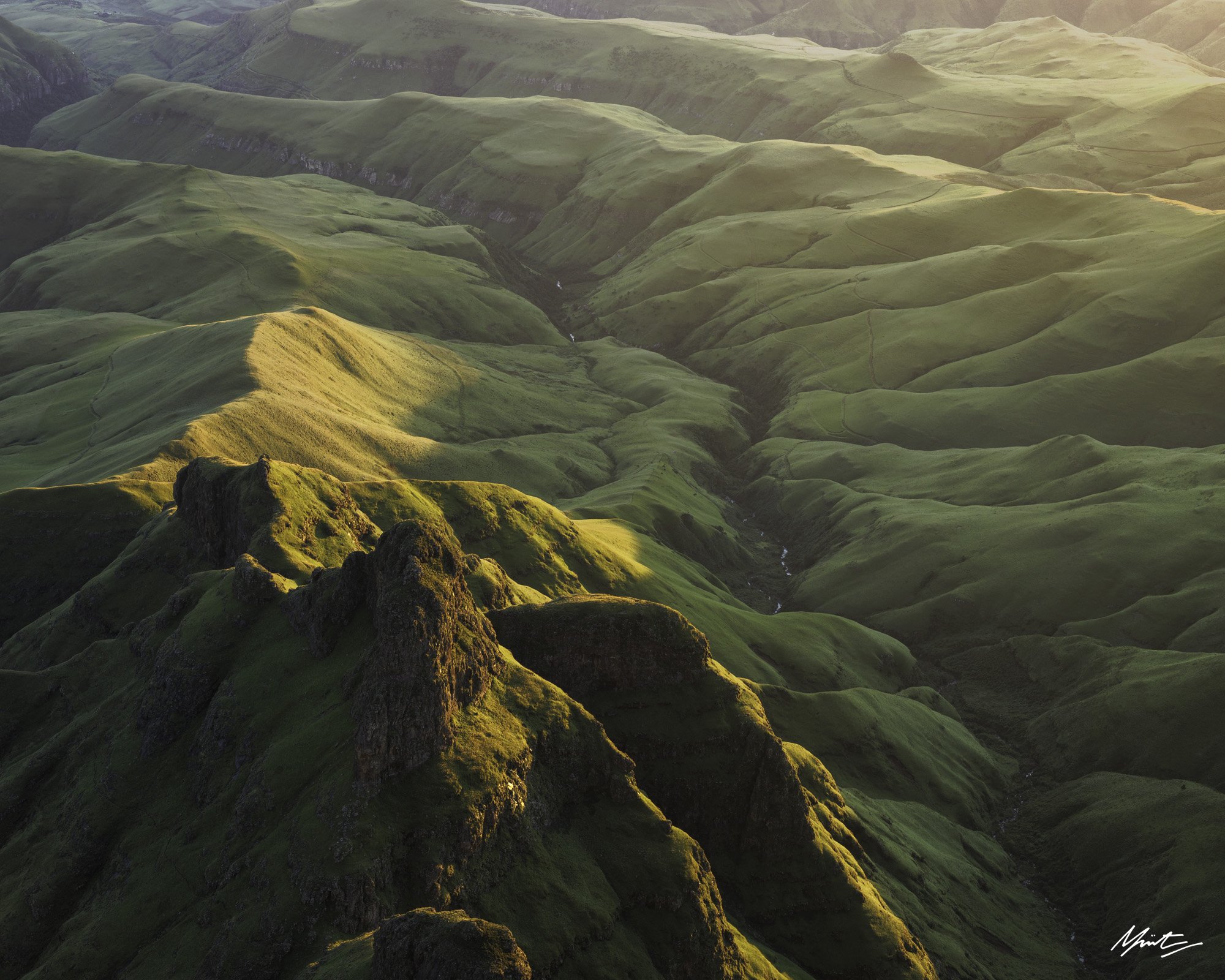
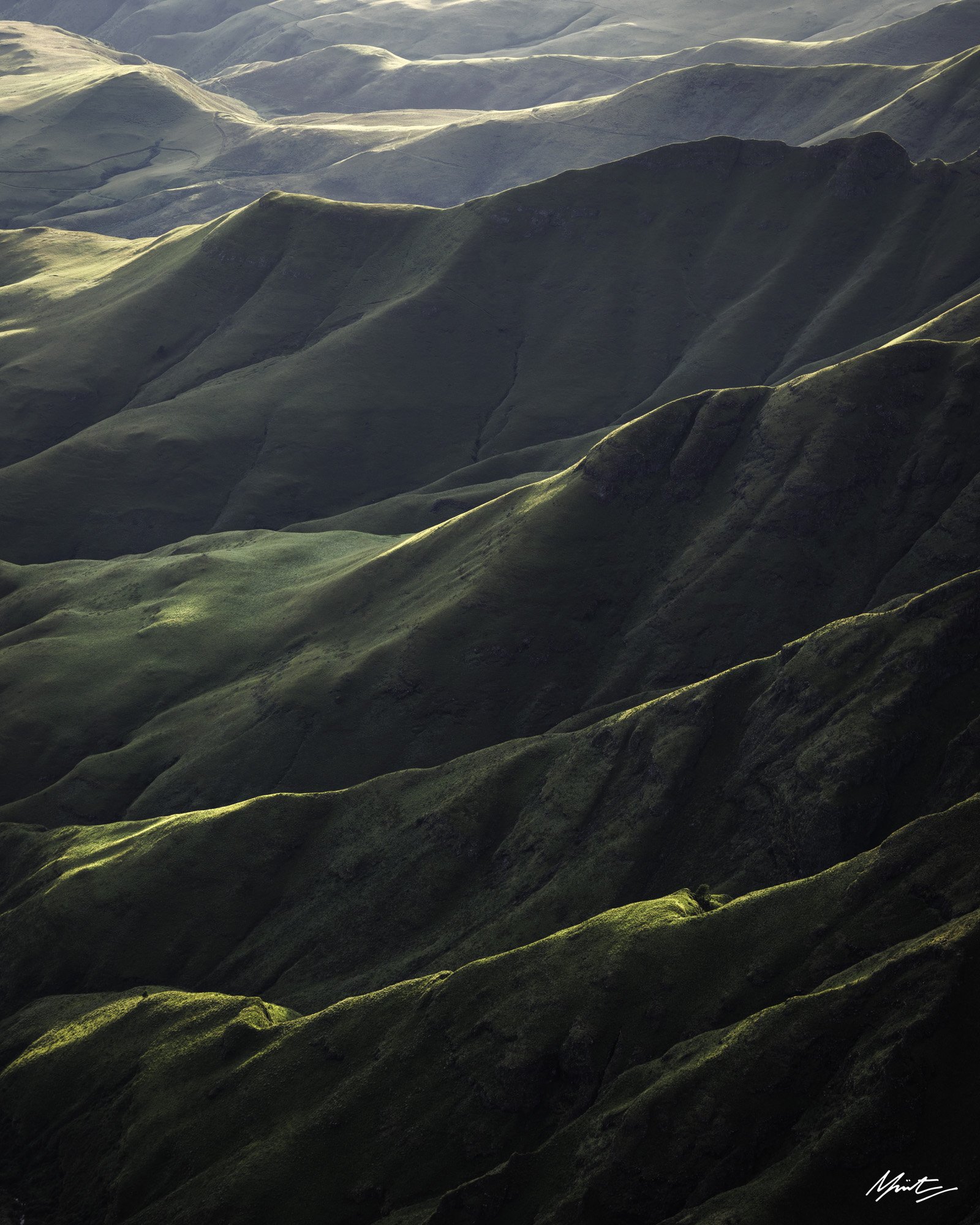
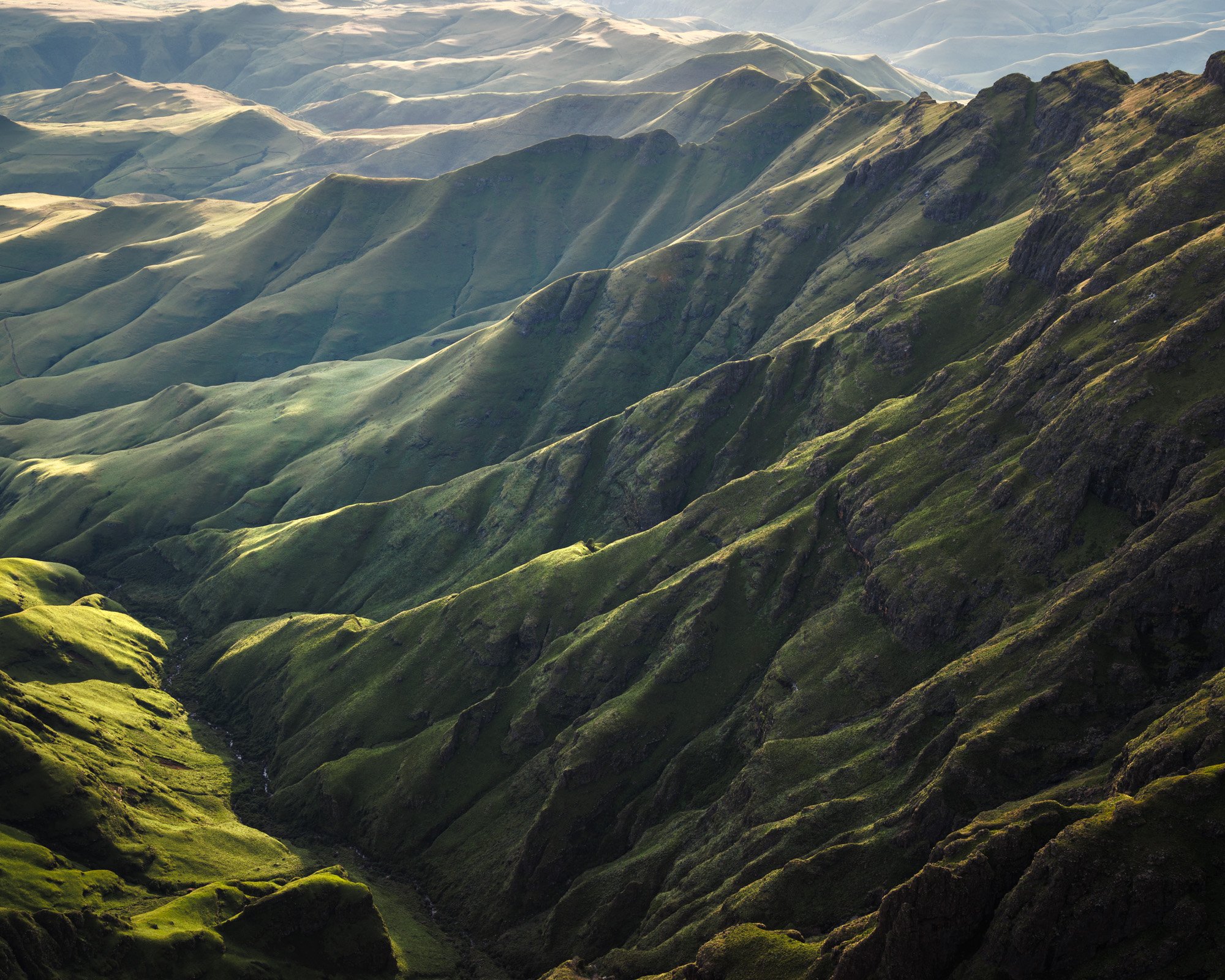
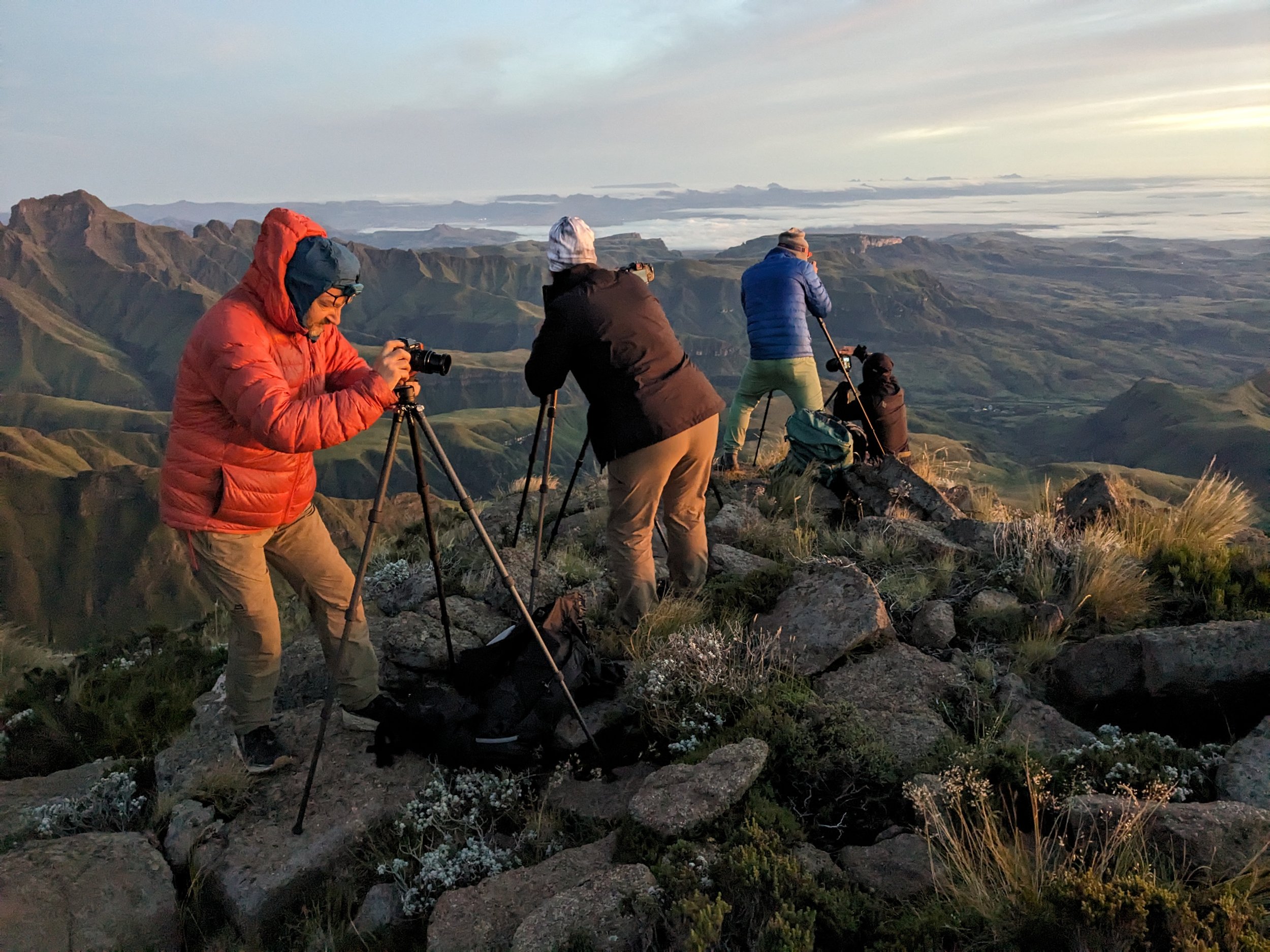
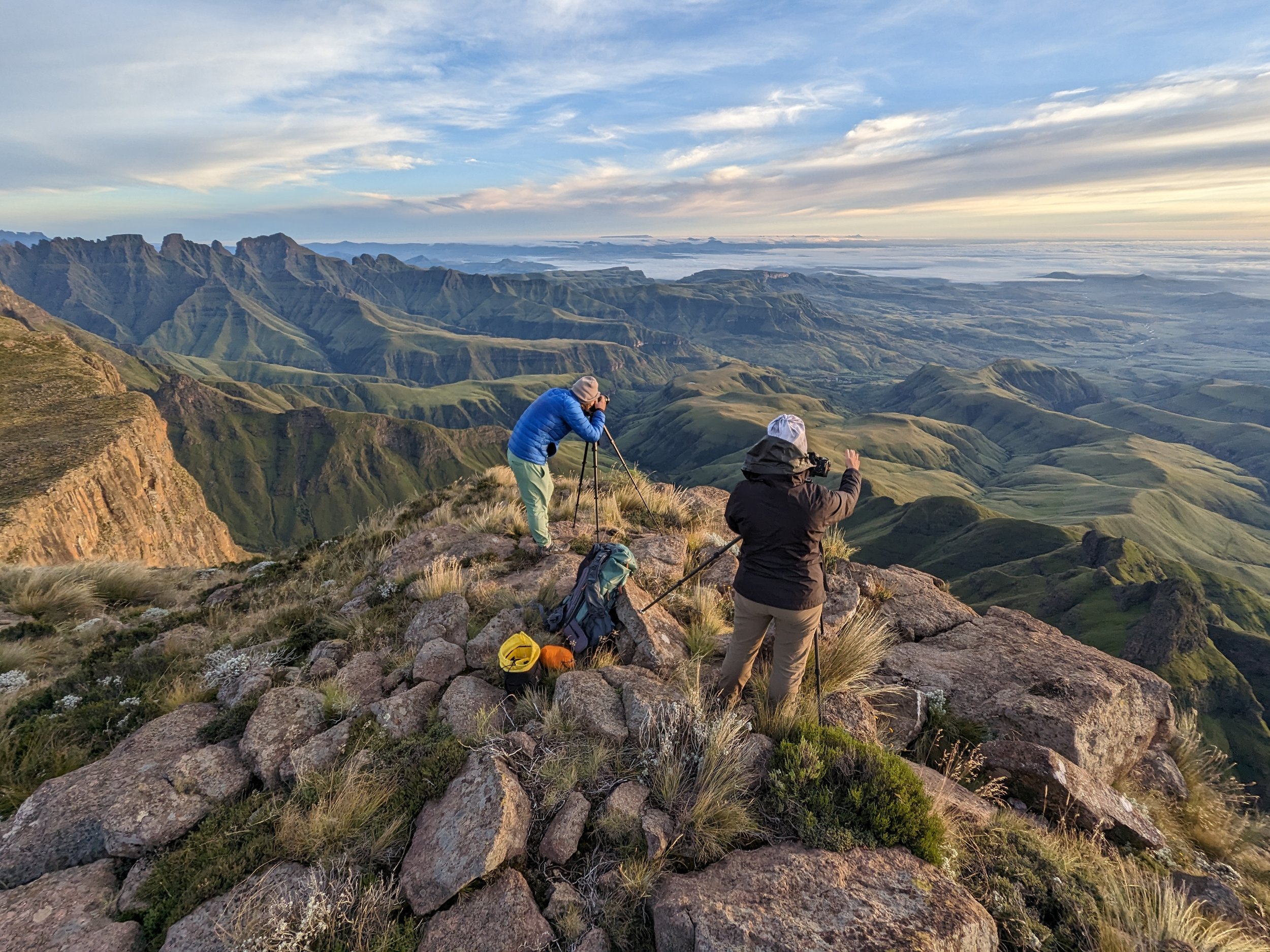
The walk down Organ Pipes Pass via The Camel and Windy Gap was epic. It took us across some fairly exposed minor scrambling, which everybody breezed through. We had all found our mountain legs. It was quite surreal to be walking down the ridges that we had just been photographing that same morning. The views were quite a good distraction from what was otherwise a difficult day of walking. Roughly 1600m descent in 11km takes its tolls on the joints, but even more so in 33C+ (91F) temperatures with little to no water sources along the way. It was certainly one of the most difficult days out I have ever done - I arrived back at the hotel completely dehydrated, despite my best intentions of drinking nearly 3L of water before setting off! I just about collapsed into a chair and quickly got some fluids and sugar into my system which slowly revived me. At times it was challenging, but the scenery and awesome people who joined me on this epic adventure more than compensated for any strenuous walking. It was incredible to have shared such a unique and transcendent experience with other like minded photographers.
At Didima Lodge after finishing the Northern Traverse
A big thank you to our guide Patrick and our team of porters, without whom the trip wouldn’t have been possible!
Thank you so much for reading! Prints of the photographs in this blog post are available to purchase. You can also join me on my next adventure in the Drakensberg. Alternatively, if you find value in my writing, photography, or just want to support my work then please consider making a small donation below. Thank you.



